In “Independent Study in World Cinema,” a self-educated film nerd attempts to fill in some fairly serious gaps in his self-education. In this long overdue 11th entry in the series, we look at a masterpiece of naturalist French cinema, Jean Renoir's Grand Illusion.
Though it's now been several years since the last entry in my Independent Study in World Cinema, it turns out to be a happy coincidence that Grand Illusion (1937) followed Triumph of the Will on my arbitrarily assembled syllabus.
For Jean Renoir's film—set during one world war, and released on the cusp of another—functions as the perfect antidote to Riefenstahl's oppressive paean to fascism. Where Triumph was dehumanizing, Illusion is unfailingly humane. Where the former adhered to strict, objectifying formalism, the aesthetics of the latter are wonderfully loose, creating room for the messy, subjective experiences of characters and viewers alike. Where Riefenstahl celebrated and perpetuated a rigid, state-mandated ideology, Renoir rejects mindless patriotism and insists that connections can be made across the artificial divisions of politics, class, nationality, faith, gender, and language. Triumph of the Will was a record of how individual humans can be subsumed into the heartless machinery of war; Grand Illusion is about how, even in war, it is possible and necessary for individuals to retain their humanity.
It's no wonder that the Nazi Minister of Propaganda, Joseph Goebbels, declared Jean Renoir "Cinematographic Public Enemy Number One," and ordered all copies of Grand Illusion seized and destroyed. Watching it made me think of the sign folksinger Woody Guthrie put on his guitar in 1941: "This machine kills fascists." As powerfully now as it did then, Grand Illusion reminds us all that humane art is one of the greatest weapons we have against demagoguery and despotism, and that cinema is—as Roger Ebert once said—"a machine that generates empathy."1
BACKGROUND
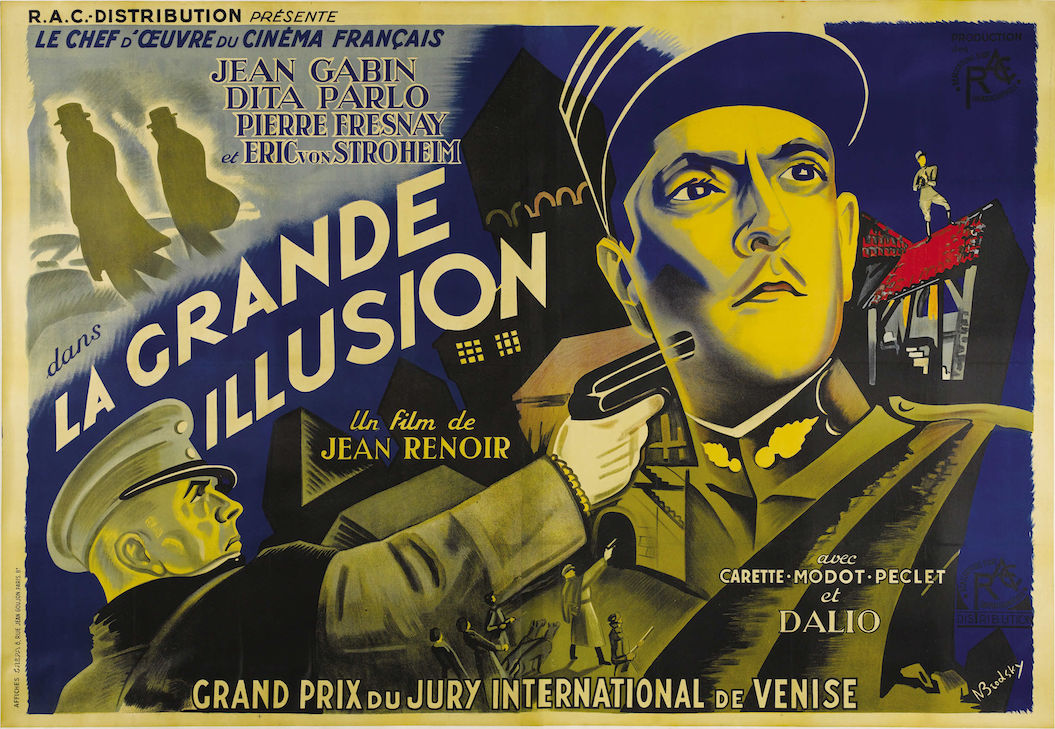
Born in Paris on September 15, 1894, Jean Renoir was the second son of the impressionist painter Pierre-Auguste Renoir, and—to his chagrin—one of his father's favorite models. As Jean recalled in his 1974 memoir, My Life and My Films:
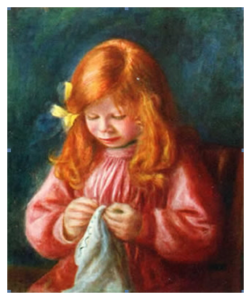
My father loved to paint my hair, and his fondness for the golden ringlets which came down to my shoulders filled me with despair. At the age of six, and in spite of my trousers, many people mistook me for a girl. Street urchins ran jeering after me, calling me 'Mademoiselle' and asking me what I had done with my skirt. 2
Jean grew up surrounded by art, artists, and models, but it was his beloved nurse Gabrielle Renard who instilled in him a love for the performing arts: first through the puppet shows of Guignol, then through theatrical melodramas, and finally through cinema. Reading his recollections of his childhood, we hear an awareness of how stories shape a person's character, instilling decency and empathy. Of his early love of The Three Musketeers, for example, Renoir writes: "Without putting it into words, I went through life saying to myself, 'I am a man of honor.' I walked the streets in search of orphans to be saved and travelers in danger, attacked by bandits whom I drove off with magnificent flourishes of my sword."3
The romance of the musketeers helped lead Renoir into the army, but that romance did not wholly survive his experiences in the First World War. "The motherland and the national honour are noble ideals," he discovered, "but to someone crouching in the bottom of a trench they are not worth a pair of dry boots."4 Jean was severely wounded in the leg by a sniper in 1915, and he would walk with a painful limp the rest of his life—something he came to see as an advantage. ("A person who limps does not see life in the same way as someone who does not limp," Renoir wrote.5)
After his convalescence, Renoir signed up to return to the war, now as a pilot. It was just before he began his training, while on leave in Paris, that he first fell in love with the movies, specifically through the work of Charlie Chaplin. "To say that I was enthusiastic would be inadequate," Renoir wrote. "I was carried away."
I saw every film of his that was shown in Paris again and again, and my love of him did not grow less. I began to be interested in other films and became a fanatical cinema fan. Charlie Chaplin had converted me. I reached the point of seeing three feature films a day, two in the afternoon and one in the evening. The cinema was beckoning me.6
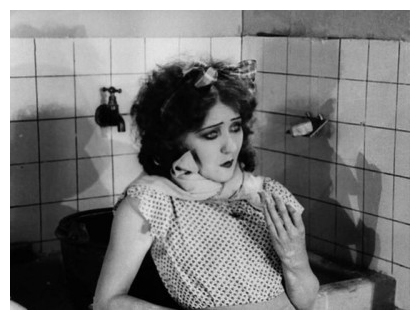
After the war—and just a few weeks after his father's death—Renoir would marry one of his father's models, a long-time member of the household named Andrée Heuchling, known as Deedée. It was love for Deedée, as much as love for cinema, that decided the course of Renoir's career. ("I must insist on the fact that I set foot in the world of the cinema only in order to make my wife a star," Renoir wrote.7)
Deedée took the professional name Catherine Hessling, and she starred in the first film Renoir wrote, Backbiters (1924), directed by Albert Dieudonné. Their next film was Renoir's directorial debut, The Whirlpool of Fate (1925), and he and Catherine would make four more films together. Renoir financed these films himself by selling off his father's paintings, and they were not successes. "Since my private means consisted essentially of the pictures bequeathed to me by my father," Renoir wrote, "my excursions into cinema were marked by the disappearance of canvases which were like a part of myself."8 Their marriage, collaboration, and (for the most part) Hessling's career ended with their separation in 1931, but Renoir had already begun to be offered more opportunities to direct.
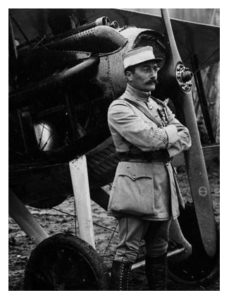
We will have the chance to discuss Renoir's career further in our next entry, so for now let's skip straight to Grand Illusion. Its genesis dates back to Renoir's experiences in the First World War, and specifically to his encounters with a daredevil French pilot named Armand Pinsard, who had appeared from the clouds, as if by magic, to save Renoir's life when he was under attack by a German Focke in 1915. Twenty years later, while Renoir was directing Toni (1935) in the South of France, the production kept being interrupted by planes from a nearby flight school. Renoir went to plead for some peace, and discovered that the commander of the airfield was none other than his old comrade Pinsard. The two men struck up a friendship, and Pinsard regaled him with stories. Over the course of the war Pinsard had been shot down seven times by the Germans, captured seven times, and managed to escape all seven times from the POW camps to which he'd been sent. These tales became the inspiration for Grand Illusion, and Pinsard became the model for its protagonist, Lt. Maréchal.
Renoir developed the screenplay with his collaborator Charles Spaak, and spent several years trying to find someone to finance it. ("I was not, and still am not, 'commercial,'" Renoir wrote, in 1974.9) Through the wrangling of Renoir's friend Albert Pinkevitch, and the attachment of established French film star Jean Gabin, private producers were finally lined up to support a very bare-bones production budget. Concessions were made—a chateau had to become a farm house, and all scenes with actual airplanes had to be scrapped—but Grand Illusion went into production in the winter of 1936. Gabin would play the lead, Lt. Maréchal. Stage and screen star Pierre Fresnay would play the aristocratic French officer, Captain de Boëldieu. Marcel Dalio would play the Jewish banker, Rosenthal, who becomes Maréchal's partner in escape. Dita Parlo—familiar to my readers from L'Atalante—would play the German war-widow, Elsa. And, in a bit of inspired casting, Renoir expanded the minor part of a POW-camp commander, Captain von Rauffenstein, into a role worthy of one of his cinematic idols, director Erich von Stroheim.
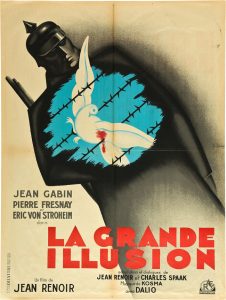 Unlike every other film Renoir had made, Grand Illusion was an instant critical and financial success. It premiered at the Venice Film Festival in 1937, and would almost certainly have won the grand prize had not the patron of the festival been Benito Mussolini. (The film's anti-fascist themes were a little too clear to be awarded what was then still known as "the Mussolini Cup.") Instead, it won a special prize for "Best Artistic Ensemble." The Third Reich, as mentioned above, banned the film and ordered all copies confiscated and destroyed, but it became a hit elsewhere in Europe, and found a huge following in the states, where it ran for more than six months. Franklin and Eleanor Roosevelt were among its biggest proponents: The film was screened at the White House on Mrs. Roosevelt's birthday, and the president is alleged to have said "Everyone who believes in democracy should see this film." At the 1937 Academy Awards, Grand Illusion became the first foreign film ever nominated for Best Picture, and it won Best Foreign Film from the New York Film Critics and the National Board of Review. Grand Illusion was still playing in theaters when the Second World War broke out. (According to Renoir, a screening in Vienna was interrupted mid-reel on the day the Nazi's marched into the city in 1938.10)
Unlike every other film Renoir had made, Grand Illusion was an instant critical and financial success. It premiered at the Venice Film Festival in 1937, and would almost certainly have won the grand prize had not the patron of the festival been Benito Mussolini. (The film's anti-fascist themes were a little too clear to be awarded what was then still known as "the Mussolini Cup.") Instead, it won a special prize for "Best Artistic Ensemble." The Third Reich, as mentioned above, banned the film and ordered all copies confiscated and destroyed, but it became a hit elsewhere in Europe, and found a huge following in the states, where it ran for more than six months. Franklin and Eleanor Roosevelt were among its biggest proponents: The film was screened at the White House on Mrs. Roosevelt's birthday, and the president is alleged to have said "Everyone who believes in democracy should see this film." At the 1937 Academy Awards, Grand Illusion became the first foreign film ever nominated for Best Picture, and it won Best Foreign Film from the New York Film Critics and the National Board of Review. Grand Illusion was still playing in theaters when the Second World War broke out. (According to Renoir, a screening in Vienna was interrupted mid-reel on the day the Nazi's marched into the city in 1938.10)
Despite its tremendous success and acclaim, Grand Illusion was still a cinematic plea for peace released at a moment when the nations of the world were preparing for war: The film suffered cuts and bans from Allied and Axis governments alike. Heavily censored and edited versions circulated during the war years, and the original negatives were feared lost. The film was finally recovered in a butchered form in 1946, and Renoir himself reconstructed it as best he could in the late 1950s.
Ironically, however, it was the very machinery of state oppression that saved the original Grand Illusion, as Stuart Klawans explains in The Nation:
As is well-known, Goebbels declared Grand Illusion to be “Cinematic Public Enemy Number One,” and the Nazis confiscated prints of the film wherever they could be seized. It is less well-known that a Nazi officer in occupied Paris—Dr. Frank Hensel, a co-founder of the International Federation of Film Archives—safeguarded many films by shipping them back to the Reichsfilmarchiv. For years, it’s been assumed that the original camera negative of Grand Illusion was destroyed in 1942 by an Allied air raid on Paris; but in fact, thanks to Hensel, the primary materials of Cinematic Public Enemy Number One were by then in a vault in Berlin.
That vault happened to be in the sector that became the Russian Zone. In 1945, the camera negative of Grand Illusion rode to Moscow on a Red Army truck, along with a multitude of other films, to build the Gosfilmofond. But the Soviet archivists apparently did not realize what they were holding–and neither did the French archivists at the Cinémathèque de Toulouse, who received the camera negative in the mid-sixties as part of an exchange program. Grand Illusion was not considered to be a lost or mutilated film; and so nobody took a close look at the cans until the early nineties, when they were shipped from Toulouse to the main French archive at Bois d’Arcy for cataloguing and preservation.11
Grand Illusion—fully restored from this rediscovered negative—was finally re-released in 1999, and issued on DVD as the very first release of The Criterion Collection. Writing in the New York Times, Janet Maslin said:
One of the most haunting of all war films features only a single casualty, and that of a man who dies in bed. Yet Jean Renoir's classic 1937 Grand Illusion, an oasis of subtlety, moral intelligence and deep emotion on the cinematic landscape this summer, remains an implicitly devastating indictment of battle. […] This version looks especially lucid, but Renoir's masterpiece has a humane resonance that would be felt on even the scratchiest of prints.12
While there are films that have earned equal or greater respect from aficionados—including Renoir's next picture, and our next entry in this series, The Rules of the Game—I'm not sure there are many films held in such universally affectionate esteem. Critic Pauline Kael, writing for The Atlantic in 1965, called it the greatest achievement in narrative film. "It's a little embarrassing to state this so baldly," Kael admitted, "but La Grande Illusion […] is just about a perfect work (in fact, I can't find a flaw in it)."13
And, while Citizen Kane is widely considered the greatest film ever made, it's worth noting the opinion of that film's director, Orson Welles. In a 1970 interview, Dick Cavett asked Welles to quickly name two movies he would load onto the ark to save for posterity, and Welles could only think of one. "Grand Illusion, and something else," Welles said.14
GRAND ILLUSION, ACT ONE: CAPTURE
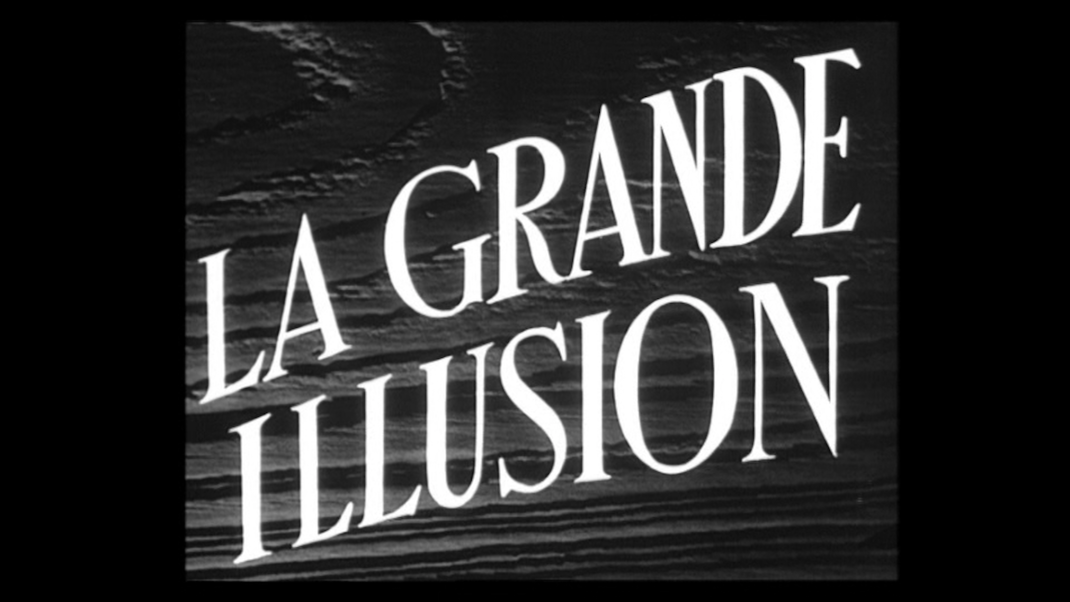
I have a confession to make: Each time I watch one of these universally-acknowledged masterpieces for my Independent Study in World Cinema, I go into it with a secret fear that this time I just won't get it. It is not so much that I'm afraid I won't like the film in question. (I did not, as it turned out, much "like" Metropolis or Man with a Movie Camera, after all.) The larger concern is that I just won't see what all the fuss is about: that I'll be unimpressed, uninspired, uncomprehending of why the film in question is considered so important in the first place. The worse-case scenario, of course, would be to find I just had nothing much to say about a movie.
Thankfully, it hasn't happened yet, and it certainly didn't happen with Grand Illusion. But this nagging fear lingered longer through my first viewing of this film than it has through any other, for Grand Illusion is a deceptively simple film, with almost no formal or stylistic flourishes. As Kael says:
In cinema there is the artistry that brings the medium alive with self-conscious excitement (Eisenstein's Potemkin, Orson Welles's Citizen Kane) and there is the artistry that makes the medium disappear (La Grande Illusion, De Sica's Shoeshine). La Grande Illusion is a triumph of clarity and lucidity; every detail fits simply, easily, and intelligibly. There is no unnecessary camera virtuosity: the compositions seem to emerge from the material. It's as if beauty just happens (is it necessary to state that this unobtrusive artistry is perhaps the most difficult to achieve?).15
Renoir, indeed, makes the medium disappear. On first viewing, we are likely not to be conscious of it at all, because Renoir's camerawork is seemingly effortless, and remarkably unobtrusive. Shots are composed not to dazzle or stun, but to simply tell the story. It is only on subsequent viewings that we appreciate that this apparent casualness is not at all the same thing as carelessness. Indeed, what we see throughout Grand Illusion is a thoughtful, subtle, very deliberate marriage of form and function. (Director Francois Truffaut, who cited Renoir as a tremendous influence on his own films, referred to it as a "styleless style."16)
Consider the opening scene. We fade in on an overhead shot of a phonograph, playing a popular turn-of-the-century ditty called "Frou Frou." A pair of hands rests on the phonograph, and the camera pans up to find a French pilot, Lt. Maréchal (Gabin), staring nostalgically down, singing along to himself with the record. (He doesn't really remember the words, but he chimes in strongly on the chorus.) Behind him, out of focus, we can see men sitting down at a table. The camera draws slightly back, taking in more of the room as Maréchal turns and crosses it. As the background comes into focus, we see we are in the officers' club of a squadron of the French Flying Corps. A bartender stands behind a makeshift counter, while men gather to drink and talk at small tables. The camera pans right as Maréchal walks over to speak to a friend about whether he can get a ride to Epernay—there is a girl there named Josephine that he wishes to see—and then left again as he returns to his place at the phonograph. But, in the same movement, the camera has picked up another officer, who follows Maréchal back across the room to tell him his courting will have to wait: The pilot has been requested for a mission. The camera follows them across the room and out the door, then swings back to show the bar, and down to a sign identifying this unit as Escadrille MF 902.
The entire sequence is barely 60 seconds long, and nothing about it is particularly showy or obviously remarkable. (You may well wonder why I'm bothering to discuss it.) And yet, both formally and thematically, I think it serves as a perfect introduction to the film.
First of all, in terms of the camerawork, it's a lovely example of Renoir's effortlessly unobtrusive style. We don't even necessarily notice, but it's all one shot. (There is a quick, almost unnoticeable cut as Maréchal leaves the room, but that is all.) Without drawing attention to itself, the camera glides up and down, pivots left to right (and around obstacles, like the phonograph), moving seamlessly from close-up to medium-shot to wide-shot and back again as it pleases. As we shall see throughout the film, Renoir (with his nimble cinematographer, Christian Matras) is a master of the long, sustained take, which serves a number of purposes.
First—and least romantically—long takes are practical: Grand Illusion was shot on a shoestring budget, in just over three-months, and repositioning bulky cameras to achieve new angles was time-consuming and expensive.
Secondly, these long takes contribute greatly to the realistic, naturalistic feel of the film. Frequent cuts and arch angles can draw attention to the filmmaker, subliminally taking viewers slightly out of the story by emphasizing the fictional, constructed nature of the film. Here, however, the camera moves—and observes—as a person would, not as a machine does. (It is—to use a word I'm going to struggle not to overuse—more humane.)
Finally, as we'll see better in later scenes, this style perfectly suits the themes of the film: The camerawork and editing do not divide people from each other, but seamlessly connect them, drawing together actors and characters alike to common purpose. Literally, spiritually, and stylistically, Grand Illusion is a true ensemble film.
I also want to stop briefly to discuss the content of this seemingly almost meaningless scene. It is no coincidence, I think, that the first shot of the film is of the record player, playing a pre-war song, and of a military man looking down at it wistfully. There is scarcely a scene in Grand Illusion without some reminder that art, literature, and music are important: The background of the film is replete with books, pinned-up artwork, and musical instruments. Important, too, is romance (Maréchal's longing to get to Josephine), the camaraderie of the men, and humor. (The sign on the bar—which, incidentally, is not there in the wider shots, and was probably the afterthought reason for the one cut in the scene—is whimsical: "Liquor kills! Liquor drives you crazy! The squadron leader drinks it!" it reads.) If Grand Illusion is a war movie, it is the warmest, most human-scaled of war movies: It prioritizes not the fighting itself, but the qualities of beauty, joy, and empathy that are antithesis and balm to war itself. "She'll just have to wait," Maréchal says of his Josephine, with a sad smile, when he is called to duty.
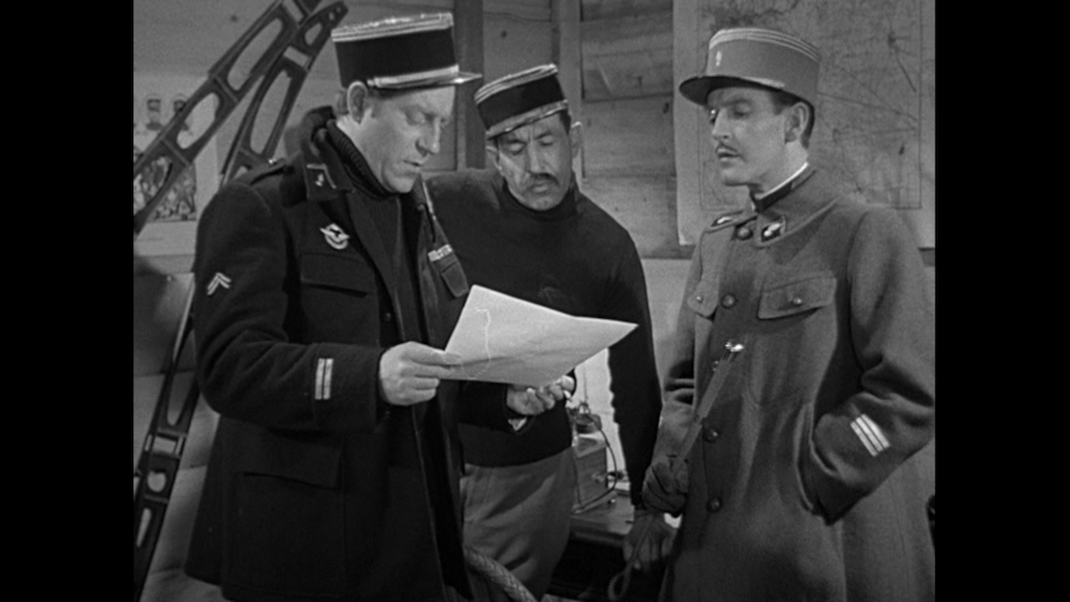
When Renoir employs a cut, it is to a purpose. The next scene is disconnected from the previous one because the man it introduces is disconnected: Captain de Boëldieu (Fresnay). Renoir could have saved himself a separate set-up by staging this conversation in the bar, but that wouldn't feel right: Boëldieu, at this point, doesn't belong amidst that easy, democratic camaraderie. We already have a sense of Maréchal as a working-class, populist figure, and here we meet his opposite number; everything about Boëldieu—his features, his bearing, his formal uniform, his monocle, his silver-tipped riding crop, even the de in his name—instantly marks him as an upper-class man, a member of the French aristocracy. He wants Maréchal to take him up in a plane, to go investigate a mysterious smudge on a reconnaissance photo. (The mystery of the smudge turns out to be irrelevant to the film, but stick a pin in the larger concept of ambiguous lines on maps: That will be important later.)
It is at this point in the film that Renoir had hoped to shoot scenes with airplanes, for the next thing that happens in the story is that Maréchal and Boëldieu are shot down by the Germans. But the budget constraints of Grand Illusion work infinitely in its favor here, for it is inconceivable now to imagine a dogfight disrupting the perfect visual and thematic transition that follows. (Renoir apparently came to agree. "I was furious," he said, about learning they couldn't afford airplanes. "Only I thought it over a little and by the next day I saw that the film would be better without them. I often have fortunate accidents like that."17)
For we fade in on yet another Officer's Club, barely distinguishable from the one we just left. (Its layout is different, but its trappings are nearly the same, right down to the phonograph.) This bar, however, is located on a base of the Imperial German Air Service, as the squadron toasts Rittmeister von Rauffenstein (Stroheim) for shooting down his 12th plane. The setting, the music, the camaraderie of the men, even the slow pan across the bar to show pin-ups of pretty girls, all echo the earlier scene, emphasizing not the differences but the similarities between the two squadrons. "If they're officers," Rauffenstein says, of his downed foes, "invite them for lunch."
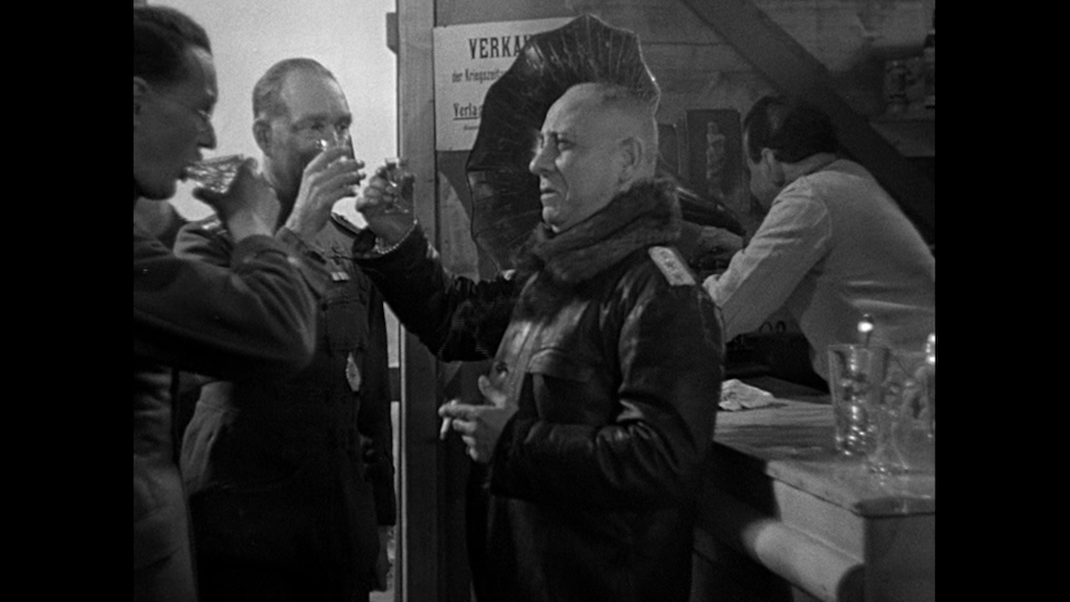
Has there ever been a "war movie" with such a conciliatory opening? In the next scene Boëldieu and Maréchal enter the German club, and are greeted with great warmth and sincerity by the man who shot them down. (Rauffenstein even apologizes to them for the inconvenience.) The men are invited to dine with the German officers, and they are treated not as prisoners but as honored guests. Rauffenstein pulls their chairs out for them, and—when Maréchal's injured arm prevents his eating—another German actually offers to cut his meat for him. The final grace note comes when the dinner is interrupted by a man carrying a gigantic memorial wreath, which the Germans are sending to the French to honor a pilot shot down in flames. The camera unites all of the men—German and French alike—in a POV shot as they turn to look, and they all stand as one out of respect. "May the earth lie lightly on our valiant enemy," Rauffenstein offers, by way of a prayer.
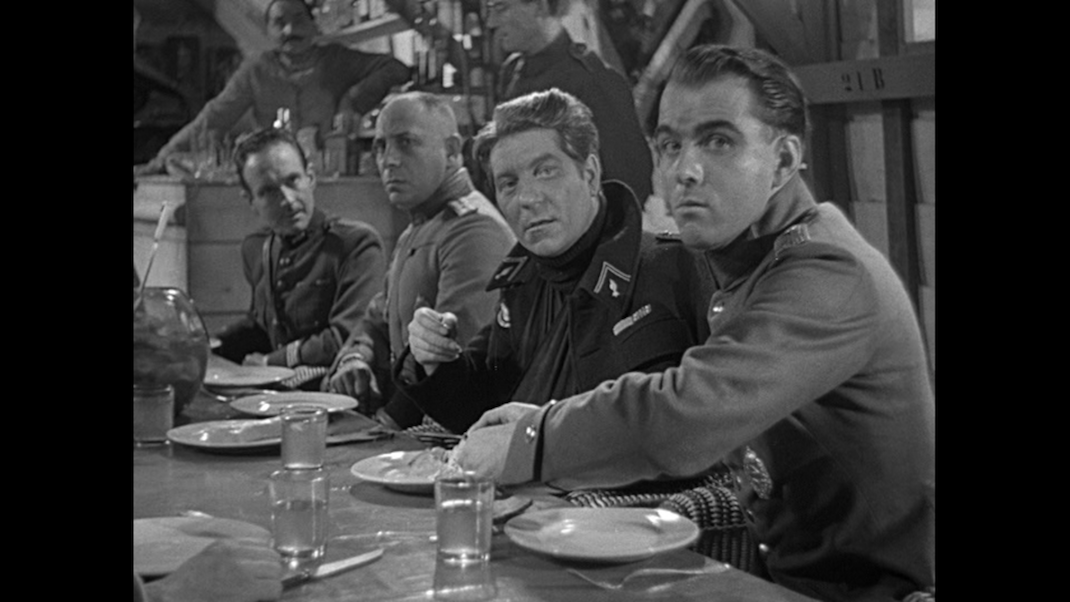
This scene also introduces the important idea that distinctions of class trump those of nationality or ideology. (It does not escape us, in all this camaraderie, that Rauffenstein only wanted to dine with the Frenchmen if they were officers: Enlisted men would not be welcome at this table.) Boëldieu and Rauffenstein instantly recognize one another as contemporaries and equals: Rauffenstein even knows Boëldieu's cousin, the Comte de Böeldieu, "a marvelous rider." Meanwhile—right beside them at the table, but in a separate conversation, and a separate shot—Maréchal and his table-mate have bonded over the fact that they are both mechanics. Even the way the four men are seated—alternating French/German, French/German—emphasizes one of Renoir's preoccupying themes, which he discussed in a chapter of his memoir entitled "An End to Nationalism":
If a French farmer found himself dining with a French financier, those two Frenchman would have nothing to say to each other, each being unconcerned with the other's interests. But if a French farmer meets a Chinese farmer they will find any amount to talk about. This theme of the bringing together of men through their callings and common interests has haunted me all my life and does so still. It is the theme of La Grande Illusion and it is present, more or less, in all my works.18
What is interesting about Grand Illusion is that Renoir sees and treats war almost as a social experiment, a temporary lowering of the walls that normally keep the different classes so separate. Boëldieu and Rauffenstein could easily have met and become friends in civilian life. (Later in the film they will reminisce about the same restaurant in Paris, Maxim's, and even the same woman whom they both knew there.) But if the paths of Boëldieu and Maréchal ever crossed in civilian life, it would have been by fleeting accident, and it is doubtful they would have really even seen one another; it is only war that will put them together in any meaningful way.
ACT TWO: HALLBACH
As my headings have already indicated, Grand Illusion can be broken down into four acts: the introduction, leading up to the men's capture; one act apiece in two different POW camps (Hallbach and Wintersborn); and the final act, set in the German countryside. In each of these, the social experiment has slightly different rules, and the walls between people, classes, and nationalities are tested in slightly different ways.
Renoir has a lot of gentle fun with the differences between the two men, and the two classes. When the men are moved to a POW camp in Hallbach, we fade in on them standing with their fellow prisoners to be instructed in the rules of the camp. In a brief but wonderful exchange, Boëldieu yawns, politely and discreetly, behind his gloved hand. Marechal, seeing this, is set off to yawn himself—largely and vulgarly, without bothering to cover his mouth. It's about 10 seconds of film that could easily have served as the opening shot of the movie, establishing exactly who these two characters are.
In this first scene at Hallbach, the Germans establish the rules. "Officers will be treated with the consideration due their rank," they explain to the prisoners. "However, you are reminded that you are subject to German law…Any German soldier here has the right to give you orders, which must be obeyed without protest." The camera pans across the prisoners—men of different ranks, different backgrounds, different nations—as this speech equalizes them; there is a leveling of the social playing field that happens, as they are all united as equals against their German captors.
A further economic parity is achieved in the next scene, as the Germans strip the prisoners of their valuables. Maréchal, naturally, reveals apologetically that he has nothing worth taking. The wealthy Boëldieu, on the other hand, protests the search. "This conduct is unbecoming," he says haughtily, as he is roughly searched. The Germans say it is their duty to search the men: This is, after all, war. "I perfectly agree," Boëldieu says. "But conduct it courteously. If not, I'll see your commanding officer."
(This "I would like to speak with the manager" energy reminds us how easy it would have been to make Boëldieu a satirically preposterous figure, but Grand Illusion never does. Renoir finds humor between the classes, but that humor is never judgmental or mean-spirited. Indeed, Boëldieu maintains his admirable dignity throughout, suggesting there may be something worth maintaining in his quaint, old-world view, even if—as he himself later accepts—the new world will have no place for him.)
In the scenes that follow, we get to know the very different men in the French section of the prison camp, as they get to know each other. Along with Maréchal and Boëldieu, there is the jokester, Cartier (Julien Carette), a former vaudeville actor. There is an engineer (Gaston Modot), and a professor (Jean Dasté, another actor familiar to us from L'Atalante). And there is Rosenthal (Marcel Dalio), a French Jew, nouveau riche, whose generous parcels keep the Frenchmen eating in style while the Germans suffer over boiled cabbage. Once again, these are men with nothing in common, who would never even meet in any other circumstances, but they form a makeshift family around Rosenthal's dining table.
(The marriage of writing and direction in this first dinner scene is another example of Renoir's unobtrusive but thematically deliberate style, noting the differences between the men in dialogue, but joining them together in the camera's eye. We begin on a conversation between Maréchal and Cartier—Cartier likes theater, while Maréchal prefers bicycling—and move to one between the engineer and Böeldieu, in which Boëldieu is surprised to learn he won't be able to buy a comfortable armchair and English cigarettes in the prison canteen. The camera moves seamlessly around the room, picking up snippets of interaction, and Renoir doesn't cut the shot until all the men are seated together at the table.)
The following scene furthers this notion of camaraderie across the classes. The actor, standing in the courtyard, yells through the window that Boëldieu's request for a comfortable armchair is a no-go: "Mr. Monocle" (as Cartier calls him) will have to learn to sit like everyone else. Renoir's camera pulls back through the window to find the engineer washing Maréchal's feet: Because of his injured arm, the man can't bathe himself, and the engineer is happy to help. As this scene plays out, they discuss the wealthy Rosenthal, whose family owns a bank. ("He's nice, the guy with the parcels," Maréchal says.) Then the engineer asks about Boëldieu, whose old world, aristocratic airs mark him as an outsider. "Just between us, can we trust your pal, the Captain?" he asks, but Maréchal reassures him. "He may seem strange, but he's okay," he says. "You can trust him."
I want to pause here for a moment to unpack one seemingly throw-away bit. Maréchal asks the other man what he did in civilian life, and the man says he was an engineer for the cadastre. Maréchal hasn't the foggiest idea what a "cadastre" is, but he pretends he does. I didn't know what a "cadastre" was either, but I had the luxury of looking it up: It's a public register showing details of ownership of real estate in a district, including boundaries and tax assessments, and is used to settle disputes and lawsuits between landowners. It is, in short, an official record of borders and property, and therefore literally a map of the lines that separate people by geography and class. Maréchal, our protagonist, is a man of the people, who presumably owns nothing: The word "cadastre" is therefore meaningless to him, as the sort of geographic and economic boundaries mapped by a cadastre are ultimately meaningless to Grand Illusion. Far from being a throw-away moment, this strikes me as thematically important, in a film that is largely about the wonderfully permeable nature of the borders between nations and classes.
And of course the men are constructing their own passage across boundaries: After lights-out, they are secretly digging a tunnel beneath the barracks in order to escape the camp. In these sequences, Grand Illusion obviously informs later escape films, such as Stalag 17, The Great Escape, and The Shawshank Redemption, and even TV shows like Hogan's Heroes. Renoir films these scenes with a jokey, joyous choreography. And indeed, with pin-ups and guitars lining the walls of the barracks, these scenes evoke summer camps more than prison camps. War seems like little more than a civilized game, a good-natured, boyishly high-spirited rivalry against the Germans. (Emphasizing this spirit of childish adventure, it is Cartier, the jokester, who goes down into the tunnel, armed with a candle and an air tube. His alarm system, which he is to tug if he gets into trouble, is a string attached to a tin can: It reminds us of nothing so much as the makeshift "telephone" of children.)
But, as Robert Frost would say—and as Renoir is careful to remind us throughout the film—this work is play for mortal stakes.19 Cartier does get in trouble: He runs out of air while digging, and almost suffocates, and no one in the cabin notices that he has tugged the string for help. In the meantime, however, The Professor has been sent to check out a disturbance outside, and speaks to a German guard named Arthur (Werner Florian), whom he addresses by first name, almost as a friend. (The Professor and Arthur even look something alike, reinforcing the commonality of all humans.) The Professor learns that another prisoner has been killed trying to escape, shot in the very spot where they've planned their tunnel to emerge. Crestfallen with this reminder of mortality, the Professor returns solemnly to the barracks, and so is fortunately in the right frame of mind to notice the fallen tin-can in time for Cartier to be rescued.
The strange spirit of dangerous play—or playful danger—continues throughout. As young German troops drill in the yard, old women from the village stand outside the gate and watch. "Poor boys," one of them says sadly. Except for the characters of Parlo's widow and her daughter late in the film, the members of this mournful Greek chorus are the only women in Grand Illusion, and their presence here—watching young men train for their probable deaths—is a reminder of the real stakes of war, which Renoir never lets us forget. But inside, the French prisoners are preparing for a theatrical revue, a silly diversion to pass the time of their captivity. "Out there, children play soldier," Boëldieu observes. "In here, soldiers play like children."
And this subtle tension permeates all of Grand Illusion. Without ever escalating into polemical conflict, the film conducts a stealth debate of ideologies and world views through the gentle contrasting of personalities. We learn, for example, why each man is trying to escape and return to the war. For Cartier, the vaudevillian, it is simple boredom, a desire to be entertained. For the engineer—the drawer of dividing lines—it is "the spirit of contradiction." ("They won't let me fight, so I'm dying to," he says.) But the important division—though Renoir pointedly does not underline it—is between Boëldieu and Maréchal. "For me, it's simple," Boëldieu says. "A golf course is for golf. A tennis court is for tennis. A prison camp is for escaping." Again, it is the notion of warfare as a game, just another field of leisurely sport, like playing golf or tennis. It is here in this throw-away line, I think, that we hear Renoir's critique of the aristocracy most clearly, particularly when we contrast it with Maréchal's motivation: "I hate being here when others are biting the dust." For the privileged upper-classes, war is a game: For the lower-classes, war means men dying in trenches. There is the romance of war—la grande illusion—and then there is the reality.
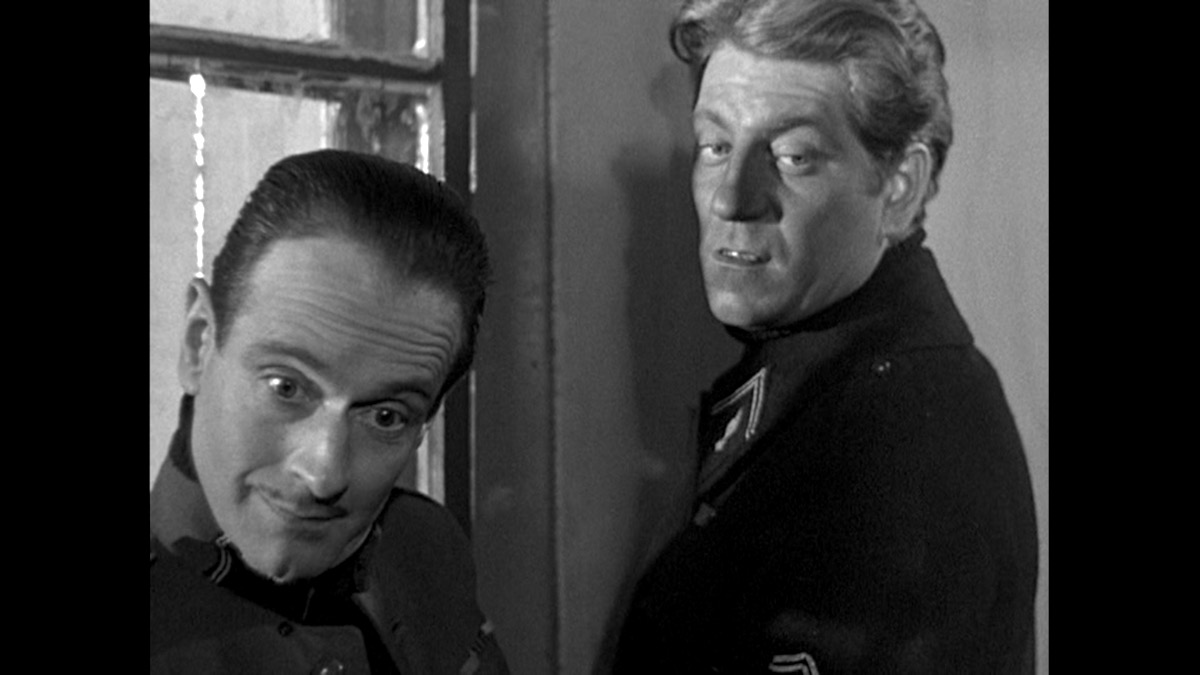
But Renoir keeps all of these things—the camaraderie and the conflict, the spirit of play and the real mortal stakes—in gentle, generative tension throughout the film. The memorable sequences around the staging of the revue, for example—far from devaluing art and entertainment as frivolous—emphasizes the importance of such endeavors. In a long tracking shot Renoir pans from a group of British prisoners rehearsing a musical number, to men carrying musical instruments, to the construction of sets and props, to find the Frenchmen gathered around a trunk full of costumes. It's a long way to Tipperary, it's a long way to go, the Brits sing. It's a long way to Tipperary, and the sweetest girl I know! The song is a reminder—like Maréchal's longing for Josephine in the opening scene, and the way the men now fondly fondle the women's clothing in the trunk—that these men are far removed from women, from romance and love and the gentler pleasures of a normal life. They are removed, as I suggested earlier, from the joys of life that are worth fighting for, but—in contrast to most other war films—they have not become hardened, brutal animals in this enforced separation.
Indeed, they find the necessary qualities within themselves: They find, if you will, the eternal feminine within the masculine illusion of war. If Grand Illusion is about how war begins to break down divisions between people, then surely one of those divisions is gender. Maréchal sets us up for this subtle fluidity by telling the long-time prisoners about how women's fashions have changed: Dresses are short now, he explains, and so are hairstyles. "Oh, it's like sleeping with a boy!" Cartier exclaims excitedly, while the more conservative Professor objects to the idea that traditional gender roles may be changing back home. "When we're not around, the women act foolish," he complains.
And then an "angel-faced" young soldier named Maisonneuve (George Forster)—who is assigned a woman's part in the revue—emerges in his costume. "It's funny, no?" he says nervously, picking at his outfit—but his appearance in drag is not played for laughs. In one of the film's most poignant moments, all conversation falls away. Renoir pans around the large, suddenly silent room to find all the men—German, French, and British alike—stunned dumb by this magical apparition of feminine beauty in their midst. (Just as Renoir learned that a man who walks with a limp sees life differently than one who doesn't, we wonder if he also knew—from spending his formative years being viewed as a girl—that there is value is locating the feminine in the masculine.)
The revue itself is a celebration of unity, humanity, and romance—until it isn't. A few days before the performance, news reaches the prisoners that the French fort at Douaumont has fallen to the Germans, and they stand solemnly in the window listening to their jailers sing the German national anthem in celebration. "What about our show?" asks Cartier. "Do we still put it on?" Of course, says Maréchal: "All the more reason. In fact, we should invite the German officers." It is a way to demonstrate that their spirits are not broken, and a delicate assertion of art as counterpoint to war.
And indeed, the German officers do attend the performance, and seem to enjoy it enthusiastically: As Renoir's camera pans around the music hall, one could completely forget that there is a war on at all, let alone that the audience is composed of different nationalities, of prisoners and captors, of enemies. It is perhaps as utopian and idealistic a moment as this determinedly empathetic film will offer, but Renoir never loses control of his tension, or lets us forget that war creates divisions even as it breaks them down. With everyone singing along to the show, news arrives that the French have retaken Douaumont, and the dividing lines are starkly drawn once more. "Stop the show!" Maréchal bellows, rushing to the stage to announce the victory. One of the performers (dressed as a woman) whips off his wig and—in a powerful scene Casablanca would steal a few years later—leads the prisoners in a rousing chorus of La Marseillaise. Maréchal pointedly walks over to the German officers as he sings, hurling the French anthem down at them like a curse.
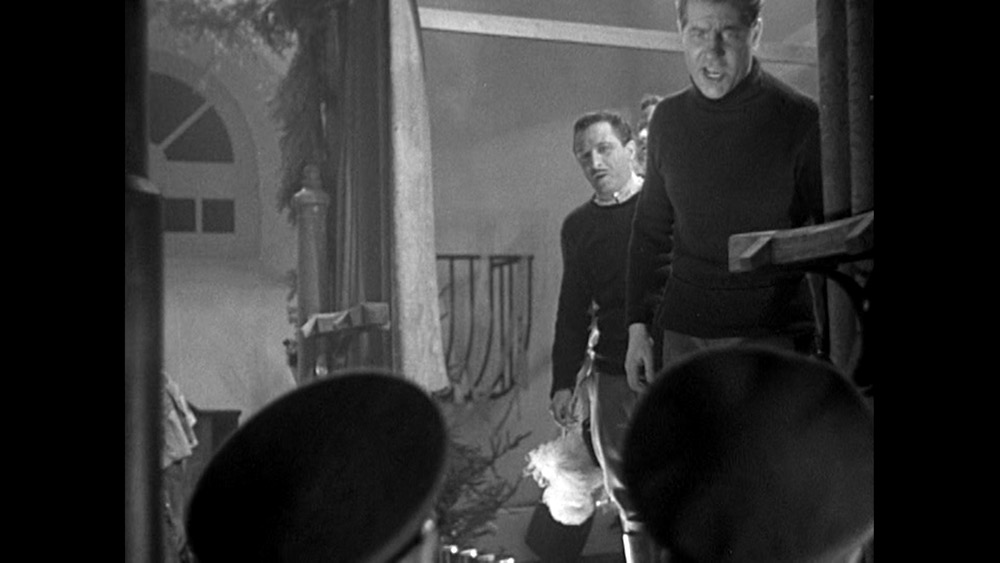
Unity and commonality are shattered: The Germans storm out, and return with their rifles, and—as we soon see—Maréchal will end up thrown in solitary confinement. The surface reading is that the frivolous artifice of the show has been ended, and the reality of the war has reasserted itself. And yet I think Renoir charges us to see that precisely the opposite is true: War is the lie—the grand illusion—and the easy camaraderie of different classes and nationalities is the natural order. The victory at Douaumont, after all, is meaningless: The Germans celebrated taking it, the French celebrated taking it back, and just a few scenes later we'll hear that the Germans have recaptured it again. ("There can't be much left of it," the professor observes sadly.) Maréchal's angry rebellion, then, is just a meaningless show of national pride over lines drawn and redrawn on some map, signifying nothing but pointless death and destruction.
The reality is the common humanity that drew the classes and nationalities together at the show, the celebration of beauty and romance and art. We see this as Maréchal languishes in his lonely prison cell. (Some time has passed, and it is unclear whether Maréchal is being punished for his outburst at the revue, or for something else. But I think the segue between the scenes suggests that we, at least, read his exile as punishment for destroying the unifying good will of the revue.) Here, we find him going slowly crazy from the solitude, futilely scraping at the walls of his cell with a spoon. "I want to see some light!" he yells at the guard. "It stinks of shit in here! I want to hear a voice! I want to hear a French voice!"
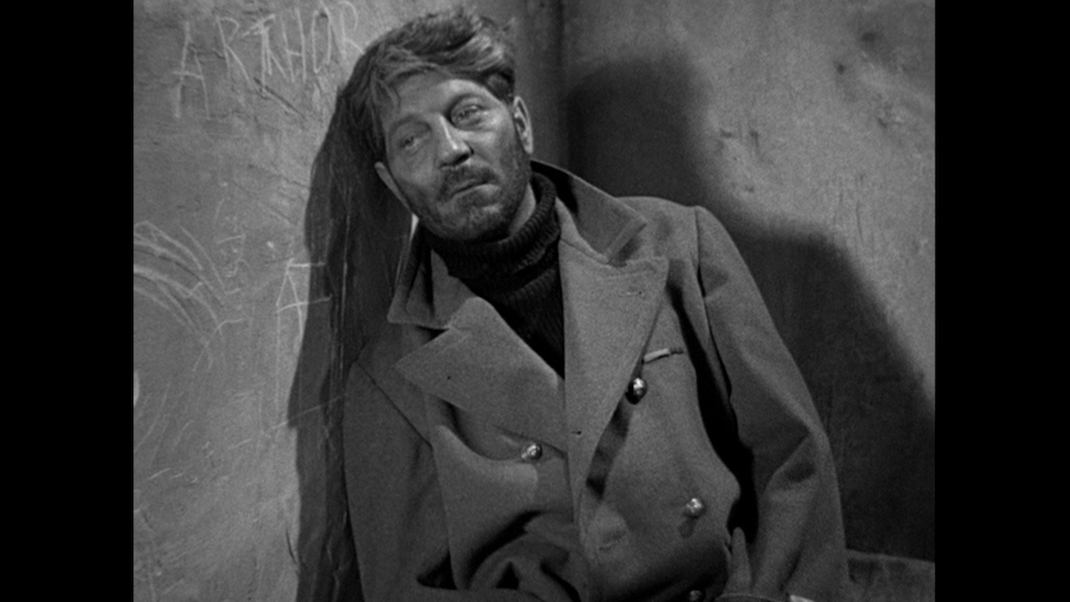
Maréchal expresses his need for human contact in nationalist terms, but in fact his French compatriots—their tunnel nearly completed—are at this moment planning to escape without him. ("It disturbs me," Boëldieu says of having to leave Maréchal behind. "But that's war: no room for sentiment.") It is, instead, from his German captors that Maréchal receives kindness and sentiment. His guard, an older man, tries to soothe him, first offering him cigarettes, and then leaving him a harmonica. The nearly catatonic Maréchal seems not to notice, but as the old guard withdraws he picks up the instrument and begins playing. (The tune is barely recognizable as "Frou-Frou," the romantic ditty he sang along to in the movie's very first scene.) The old guard smiles to hear it, and when another guard asks him what Maréchal was yelling about, he simply says, "The war is too long."
It is in these tiny moments of connection—of sympathy and empathy that cross borders of nationality and class—that we find the heart and purpose of Grand Illusion. Maréchal craved "a French voice," but his German guard gives him a harmonica instead, a gesture of kindness expressed through the universal language of music. Throughout Grand Illusion, music is seen as a powerful tool that can be put to many purposes. When Maréchal and Boëldieu first arrive at the camp, for example, it is used as code, as Cartier sings to them to warn them to guard their valuables. In the revue, music becomes the thing that brings enemies together, at first, but then—with "La Marseilles"—it suddenly becomes a weapon, a wedge to drive people apart. Later in the film, we will see music used as protest and deception, as an impromptu concert is used to distract the Germans and cover an escape. But it is in this moment, I think, that we see Renoir's clearest assertion of music (and art in general) as a shibboleth of human decency. The grace of the guard's gesture restores the spirit of common humanity that Maréchal had broken at the revue, and (symbolically) releases him from exile and allows him to return to the community.
We can, for the sake of time and space, move briefly through the remainder of Act Two, since Maréchal's return from isolation is this section's real dramatic catharsis. (Despite saying war had "no room for sentiment," Boëldieu is clearly relieved to see him return to the makeshift family, and Rosenthal actually wipes away a little tear.) In contrast, it is almost amusing how little the film—or any of the men—cares about what was supposed to be, from a plot perspective, the dramatic climax of this act: the escape. Maréchal is released from isolation just in time to go through the tunnel with the others, but it never happens: On the day they are supposed to leave, the Germans announce that all the officers are being moved to other camps. The escape they've been planning for months has been thwarted at the last minute, by sheer dumb luck, and the men seem scarcely to care, accepting it in good humor. This casualness reinforces our sense that war is something of a game for these men: the real stakes are the bonds they have formed and the commonality they have discovered. ("Gentlemen, I wish you a pleasant journey," Arthur, the German officer, tells the departing prisoners. "I hope you see your wives again soon." And the French prisoners bid him au revoir just as warmly.)
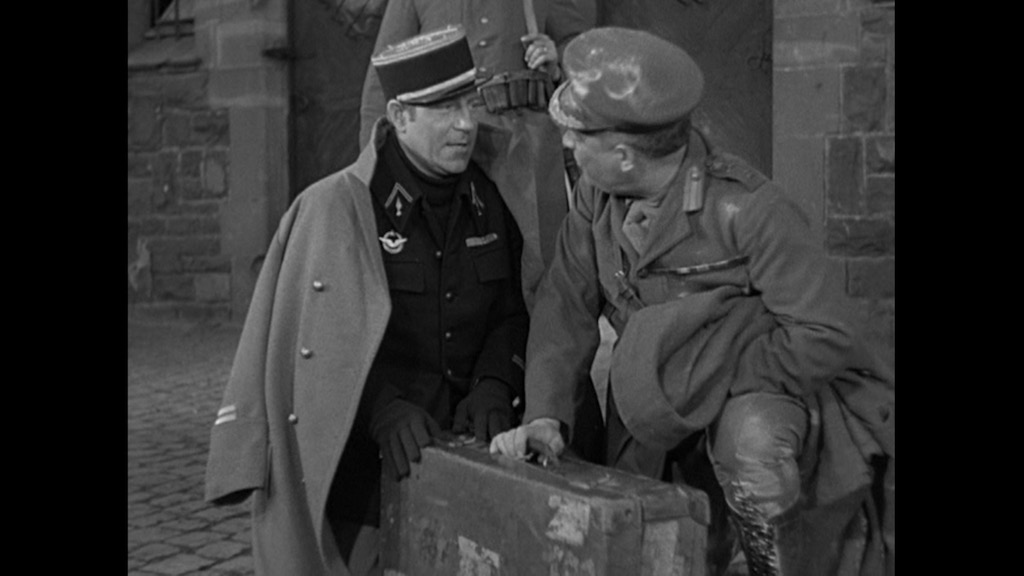
The point is punctuated by an incoming group of English prisoners, who will be occupying the barracks the Frenchmen are abandoning. Boëldieu points out that they should be alerted that there is a completed tunnel beneath the dorm, and Maréchal tries to tell one of the Brits that all they'll have to do to escape is lift a few floorboards—but the man speaks no French, and so does not understand. New to the camp, the Englishmen have not (yet) discovered the commonality that has lowered the divisions between nationalities. They are still walled off by boundaries of difference, trapped in the grand illusion.
ACT THREE: WINTERSBORN
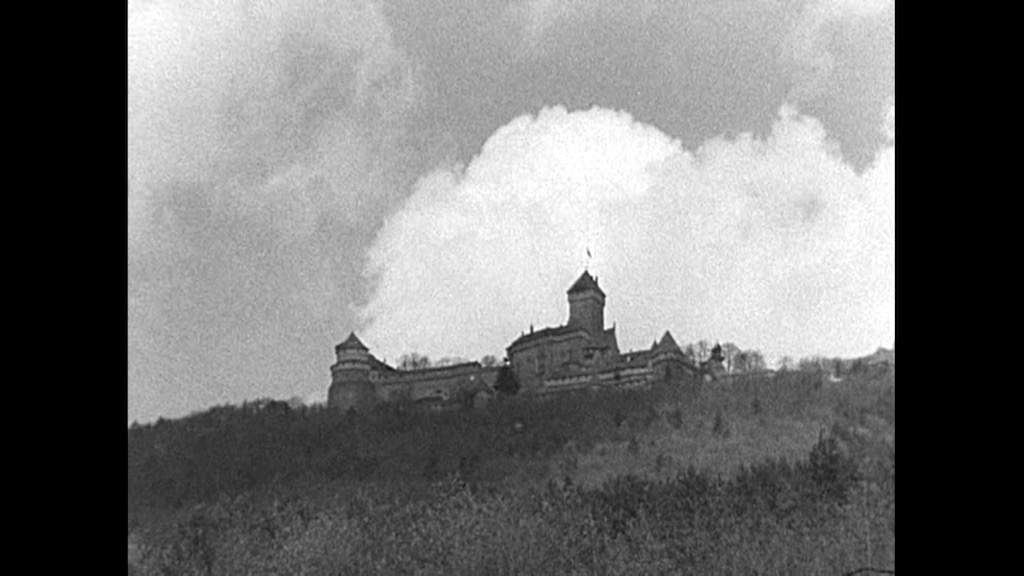
I've already discussed how Renoir's naturalistic style lets us almost ignore his very intentional filmmaking choices, and I would argue that symbolism works much the same way in Grand Illusion. It is there—it is everywhere, in fact—but Renoir's directorial lightness of touch, and his humanely realistic approach to his characters, means it is never forced: We may, in fact, only become aware of Renoir's thematic points sub-consciously, as they vibrate almost imperceptibly at the heart of the story. If cinema is, as Ebert asserted, a machine for generating empathy, every single cog in Renoir's machine here is well-oiled, perfectly balanced, and integrated so precisely with its interacting components that the entire mechanism runs smoothly and nearly silently.
Which is a long way of saying that it was only on my third or fourth viewing of Grand Illusion that it even occurred to me to think about what the change of setting in Act Three might represent. Why do it, after all, from a practical perspective? Why—in such a budget-conscious, time-crunched production—would Renoir and Spaak structure their story to require two different POW camp sets, each with its own cast of supporting characters? And why, in a film without a wasted shot or edit, would Renoir spend a full 90 seconds of precious screen-time on a wordless travel montage between the two?
But the purpose reveals itself when we consider Grand Illusion's overall project of exploring the ways war breaks down social divisions, and specifically how the First World War began to break down the dominant class paradigms in Europe. A sort of democratic camaraderie has formed between the classes (and even nationalities) in Hallbach, but that camp—its scenes staged in an army barracks—was part and parcel of the war itself: It was on the "ground level" of the class experiment, if you will. In moving the action to Wintersborn, on the other hand, Renoir moves the experiment to a higher plane, literally and figuratively. In the montage, we pass by train through the countryside, past small villages and factories and farmlands, until we finally arrive in the mountains, at a literal castle. (The Wintersborn scenes were shot at the Château du Haut-Kœnigsbourg, a medieval fortress that has been home for centuries to various strata of Germany's ruling class.) The waves of change that began on the fields of war, then—the tentative democratization that has already occurred between figures like Maréchal and Boëldieu—have now moved through the country and come to crash at the gates of European aristocracy itself.
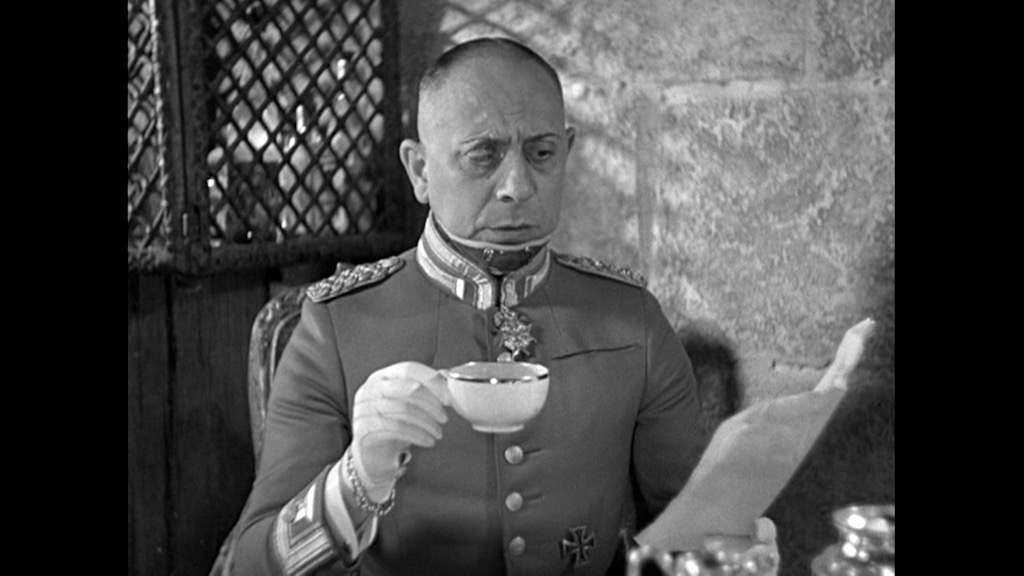
And so it is here that we re-encounter the symbol of what is both honorable and problematic about the old system: Captain von Rauffenstein. Injured and removed from combat, we now find him installed as the commanding officer of the Wintersborn prison, trying desperately to cling to ceremonial trappings of upper-class life that are slipping away from him. He's wearing his full dress uniform, but his aide informs him that they're down to their last two pairs of white gloves. He is served coffee from a fine silver set, but the coffee is "muck." On his windowsill are mementos of his riding career and, in a tiny pot, a single geranium he tends lovingly. "It's the only flower in the fortress," he'll tell Boëldieu later. "Nothing grows here but ivy and nettles." And, of course, due to injuries sustained in a crash, he is covered with burns that he hides beneath his uniform; he has steel plates in his head and knee; and his spine is fractured in two places, requiring that he wear a brace to stay upright. Representing a way of life that would not survive the First World War, he is a broken, propped-up, patchwork man, fighting to retain his identity—his airs of aristocracy, and his last illusions of beauty, privilege, and civilization—in a rapidly changing world.
(There is a poignant irony in Stroheim's playing this part. The Jewish son of middle-class parents—his father was a hat maker—Stroheim affected an air of aristocracy himself. The "von" in his name was his own invention: Born simply "Erich Oswald Stroheim" in 1885, it was when he emigrated to America in 1909 that he presented himself, at Ellis Island, as "Count Erich Oswald Hans Carl Maria von Stroheim und Nordenwall." Rauffenstein's disdain for his current duties as prison warden must have resonated with the actor as well. Stroheim had been one of the great directors of early cinema, but he was such an intractable perfectionist that his relationship with studios grew more and more contentious, and directing opportunities dwindled. By the time he co-starred in Grand Illusion, he had directed his last film. He spent the rest of his life playing supporting parts in other directors' movies, which he often resented. He feared—and he was right to fear it—that he would best be remembered for what he referred to as "the God-damned butler" role in Sunset Boulevard.20)
But it is in the character of Rauffenstein—even more so than in Boëldieu—that we feel how Grand Illusion's incredible charity towards all human beings includes aristocrats as well. Hand this scenario to any other director—and any other actor—and Rauffenstein could easily be a ridiculous character, a dandified martinet who reeked of satire. But Renoir and Stroheim never let him become that: There is satire here, and even critique, but it is gentle, understanding, forgiving, and always respectful of the man's dignity and humanity. In terms of his capacity for change, Rauffenstein is the most limited major character in Grand Illusion, but he is—perhaps because of this?—arguably the one who evokes the most sympathy.
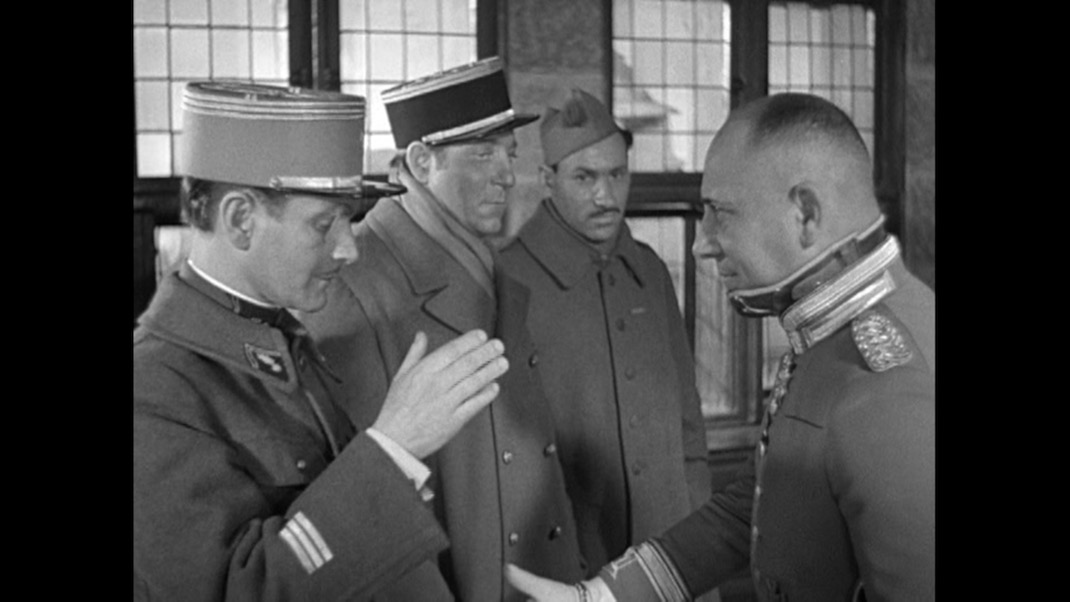
Part of this is that Rauffenstein is—there is no other word for it—lonely. Renoir is a master of intentional blocking, and the scene in which Rauffenstein welcomes the new prisoners is a fine example of the craft. Rauffenstein greets them warmly, mostly because of Boëldieu, whose name he has been excited to see on the lists. He greets them in French, bows to them, returns Boëldieu's salute, and then—we see the surprise register on the faces of the prisoners—he shakes Boëldieu's hand. He does not, however, shake the hand of Maréchal or the other officer present, Lt. Demolder (Sylvain Itkine). As we've already glimpsed—and as we'll see throughout this section—Rauffenstein's ingrained class snobbery is his tragic flaw, the limitation that will doom him to an isolation from which he so clearly would like to escape.
Watch how the tension of his self-imposed isolation plays out in this scene, as Renoir stages it. Rauffenstein initially seats himself behind a long desk, isolated in the frame and separated from the men. It is from here that he questions them on their records, including their many attempts at escape. But, once he has completed this bureaucratic duty, he comes out from behind his desk, and somewhat awkwardly inserts himself between them and this authoritative barricade. He paces back and forth in front of them—close enough to actually brush against them—and eventually seats himself chummily on their side of the desk. Finally, the scene ends with Rauffenstein standing with the prisoners, facing the desk, almost as if he were one of them.
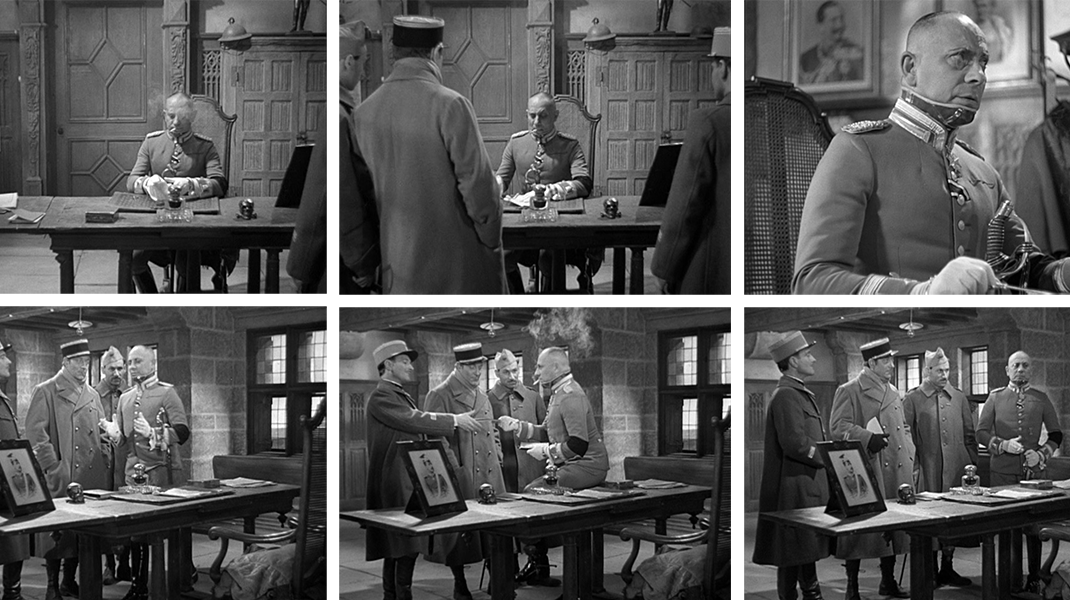
Without a single word about it—and perhaps without our even being aware of it—Renoir has just given us so much information about the terrible loneliness of this man: the way he is restrained by (and tries to navigate around) the trappings of his office and position; his longing for camaraderie; and the ways in which he is perhaps even more of a prisoner of this time and place than the captured Frenchmen.
For Rauffenstein can't change, even as the world changes around him. It's amusing to learn in passing that Maréchal has attempted to escape dressed as a chimneysweep, a German soldier, and even as a woman. ("Very droll," Rauffenstein says dryly.) As those divisions between class, nationality, and gender grow more permeable, men like Maréchal can navigate them with an ease that would be impossible for a man like Rauffenstein, or even for a man like Boëldieu. (Boëldieu has attempted to escape many times as well—through heating ducts, or by hiding in laundry baskets—but not, as far as we know, by disguising himself. "One must lower oneself, at times," Boëldieu says—but it is inconceivable to imagine him lowering himself so far as to dress as a woman. He is—as Maréchal will observe later—always, inescapably, himself.)
"Everything is popularized," Boëldieu observes, as—in one of Renoir's more humorously overt scenes on his theme—the prisoners discuss how even diseases are becoming more democratic. ("The pox used to be our privilege," Boëldieu says of the upper class. "But we've lost it, like so many others.") It is Rosenthal, the Jewish child of nouveau-riche immigrants, who articulates the theme most succinctly: "We'd each die of our own class diseases, if war didn't make all germs equal."
The section in Wintersborn, then, becomes a study of adaptation, and—in the case of the aristocrats—the limits of adaptation. It is a very thin line that separates Boëldieu and Rauffenstein, after all, but the differences are important. Rauffenstein resists the tide of change: He is trying to hold on to the reality he has always known, and he struggles to incorporate any new ways of seeing the world. When the Germans conduct a spot inspection of the prisoner barracks—overturning furniture and searching for contraband—Rauffenstein insists that the soldiers leave Boëldieu's quarters alone. He simply asks for—and receives—Boëldieu's word that he has nothing he's not supposed to have. But, he says, he couldn't accept the word of a Rosenthal or a Maréchal. "It's as good as ours," Boëldieu assures him, for Boëldieu's experiences in Hallbach have taught him to respect these men as much as any aristocrat. But Rauffenstein could never believe that. He could never believe that lower-class men might be honorable, just as it would never occur to him that an upper-class man like Boëldieu could be—as he is later in the film—deceptive.
(I'm not going to dwell on it here, but the barracks search is another excellent example of Renoir's subtle camerawork and blocking. The entire scene begins and ends on the same shot—Maréchal making rope for his escape—and in between are a lot of long, continuous takes that move around the room joining all of the men together in this indignity. The only cuts are for Boëldieu and Rauffenstein, who—appropriately—play their brief scene out in a completely separate shot.)
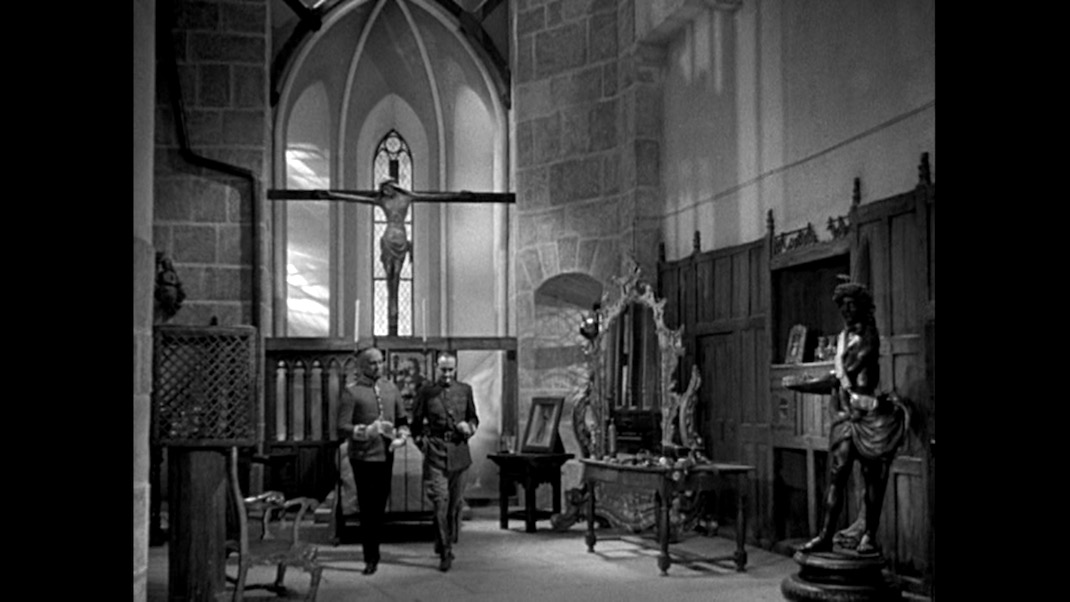
In the very next scene, Boëldieu has been invited to visit Rauffenstein in his chambers. The shot in which we first discover them there is almost unique in this section of Grand Illusion. Renoir employs very few long shots of this kind, but here it is perfect: It emphasizes the grandeur of the rarified space, while also making the men within it feel small, subsumed in opulence and history. We see their privilege, but the shot also underlines the isolation from which—as they walk towards the camera—they are trying imperfectly to escape.
There is absolutely no indication here of their being enemies, of being captor and prisoner. The two men converse as equals, even as friends. And why not? They have everything in common except nationality, and they have the exact same understanding of how their place in the world is changing. "I don't know who will win this war," Rauffenstein says. "But whatever the outcome, it will mean the end of the Rauffensteins and Boëldieus." Boëldieu does not disagree. "Neither you nor I can stop the march of time," he says. "We're no longer needed."
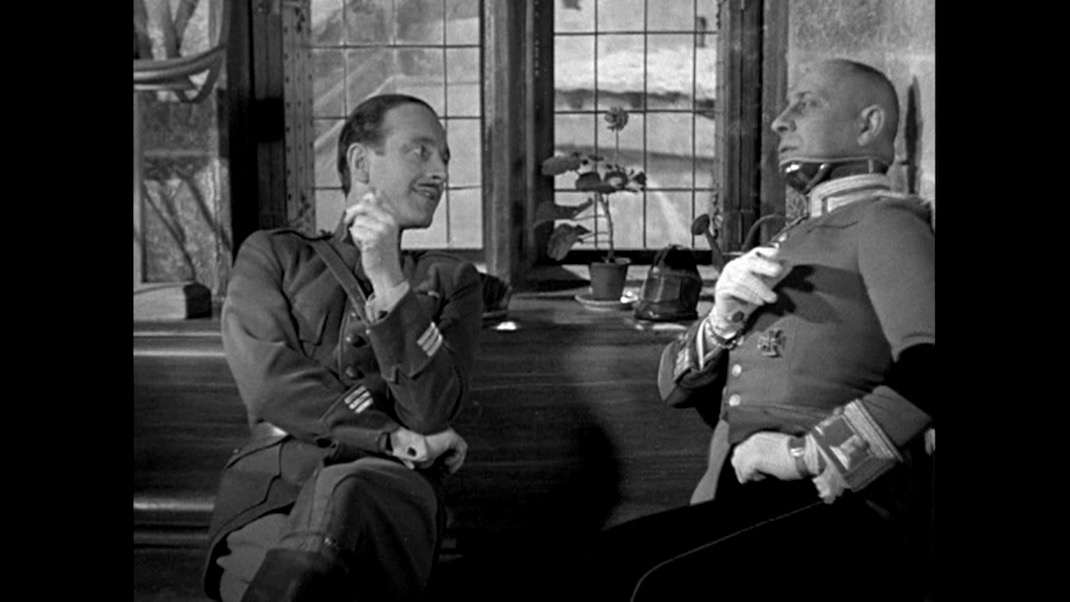
But where Rauffenstein sees change as something to lament—"Isn't that a pity?"—Boëldieu seems open-minded, even optimistic, about the future. What's important to note here, I think, is that the difference between these two men is one of neither aspiration nor aspect, but only of attitude: There will be a place for neither of them in the new world, and they both know it. They are each, in their ways, dying of their own "class disease," and the only thing to decide is how they're going to go out: fighting the future from within a sad fortress in which nothing grows, or actually helping to midwife that future into being.
If there is national pride in Grand Illusion, I would argue Renoir expresses it here. The German resists and resents the democratization of the world: He somewhat snidely dismisses the fact that Rosenthal and Maréchal are officers as "a charming legacy of the French Revolution." But Boëldieu—whose country, unlike Rauffenstein's, had a revolution against its monarchy—seems to take pride in the fact that the aristocracy has become obsolete, as if that were its purpose all along. Though he never would (and never does) articulate his beliefs so sentimentally, the spirit of the French national motto—Liberté, egalité, fraternité—seems to dwell in Boëldieu in a way it never could for Rauffenstein.
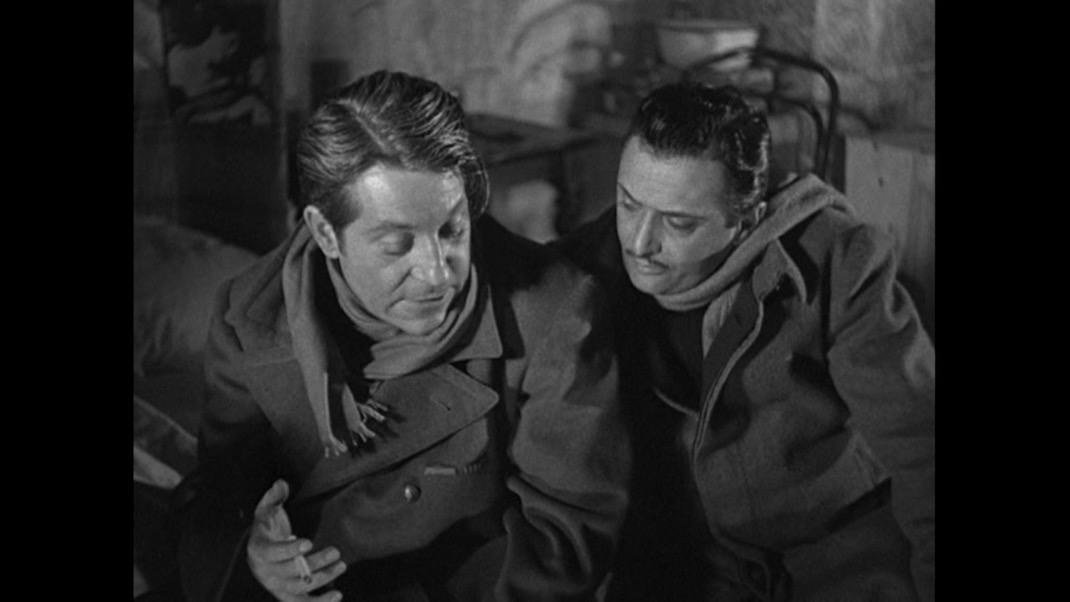
Either way, both men know that the future belongs to those "Rosenthals and Maréchals," whose value Rauffenstein can't see. Meanwhile, somewhat sadly, Rosenthal and Maréchal are having their own version of the same conversation—as they discuss their imminent escape—and they are coming to the same conclusions.
One poor and one rich, one Christian and one Jewish, these two men have little in common but their nationality—but they have an affinity with each other that neither could ever have with Boëldieu. As Maréchal says:
"I like Böeldieu. But with him, I never really feel at ease. Different backgrounds. There's a wall between us […] He's on the level. But suppose you and I were on the skids. We'd just be too bums. If it happened to him, he'd still be 'Monseiur de Böeldieu.'"
Boëldieu is "terrific," they agree, but they recognize—as Boëldieu does himself—that Boëldieu can only change so much. They will make their escape together, and they will not invite Boëldieu to come along.
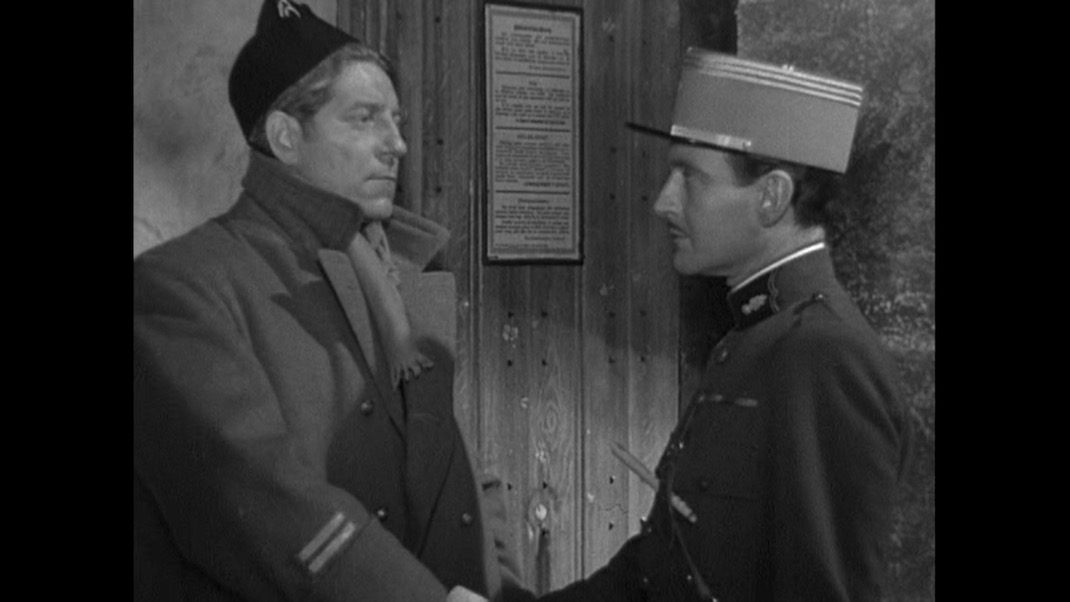
So Boëldieu has been consigned to the past, and his heroism is that he accepts it graciously, eagerly, even joyously, concerned only with how he can help Maréchal and Rosenthal escape. "A plan like yours can only work with two men," he tells them. "And I know your preference." Feeling guilty at Boëldieu's sacrifice—and his awareness of their feelings—the men protest, and several times Maréchal tries to thank Boëldieu or apologize to him. But Boëldieu won't hear of such sentimentality. "I'm not doing this for you personally," he says, "so there's no need to get mawkish."
Boëldieu shakes Maréchal's hand—as Rauffenstein did not—but even here, saying goodbye for what they both know is forever, Boëldieu is unwilling or unable to lower that wall Maréchal spoke of. "You can't do anything like other people," Maréchal observes. "We've been together 18 months, and you still stand on ceremony." Boëldieu assures him he is the same way with his own mother and wife. This is who he is, and he has reached the absolute limits of his willingness to, or capacity for, change. Once Maréchal leaves, Boëldieu—alone in the frame once more—tightens his own pristine white gloves, reminding us that he and Rauffenstein are the same sort of creature, resigned to the same sort of fate. Neither of them can expose too much of themselves, and neither of them is fully capable of touching the world.
The form of Boëldieu's sacrifice is remarkable, and perfectly in line with the themes of Grand Illusion. A fire in the Russian barracks has convinced him that any decent-sized distraction could occupy the guards long enough for Rosenthal and Maréchal to escape, but—unlike its inspiration—the distraction he chooses is not a destructive one. Evoking the spirit of play that has been present throughout, recreating the camaraderie of performance that existed during the revue, and emphasizing the power of art to combat war, Boëldieu's plan is based on music. The men stage an impromptu concert on flutes, and then—when the flutes are confiscated—on pots and pans and whatever other improvised instruments they can find. Once again, it feels more like a childish prank than a serious revolt. (The scholar, Demolder, even underlines the point: "Now I understand my students!" he says. "What a lark!") But, once again, this is play for mortal stakes.
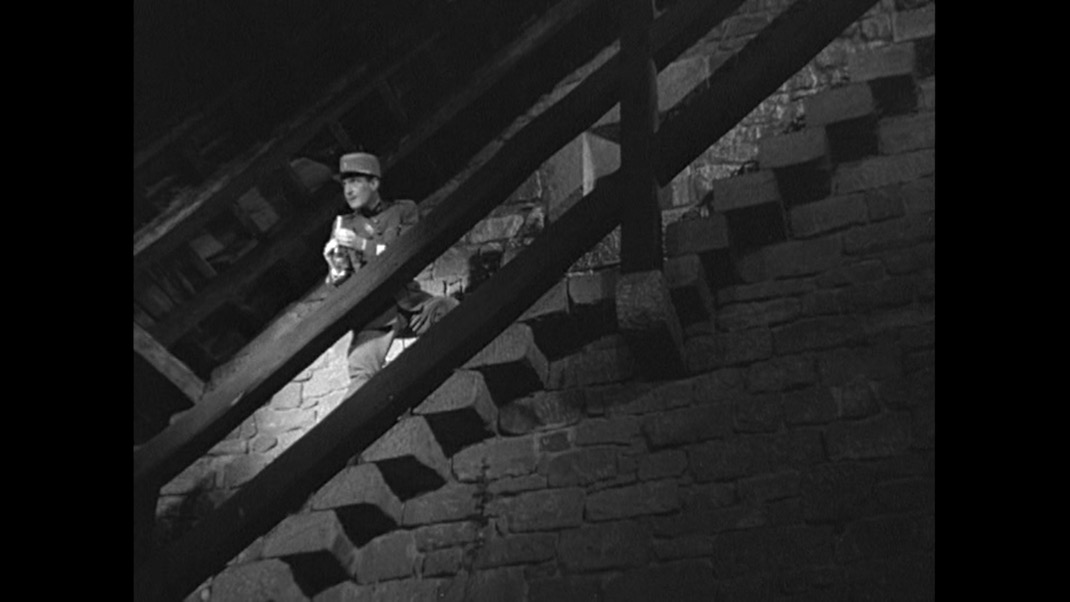
After the impromptu concert has been quelled by the guards, and all the prisoners have been assembled in the courtyard, the Germans are taking roll call of the prisoners. Their harsh calls ring out and are answered, until they reach Boëldieu's name, and a ghostly silence falls—followed by the sweet notes of a single flute, sounding out from somewhere in the castle, as all eyes look up in wonder. (Like Pauline Kael, I find bald expressions of admiration a little embarrassing, but seriously: This is as magical a moment as cinema has ever produced.) The song he plays is "La Petit Navire," a traditional French ditty about a sailor boy who—when other sailors threaten to eat him—prays to the Virgin Mary for forgiveness, and is rescued by a miracle.
Grand Illusion, too, I think, is a prayer for a miracle. It is Renoir's desperate plea to the world that the coming war might somehow be—if not avoided—at least civilized, a thing conducted between gentlemen, a thing that would not require the surrender of all empathy and decency. He hoped that by locating the humanity in the last world war, he might help infuse it into the one to come. I do not think he was naive on this point, or even particularly optimistic. But Grand Illusion tries to remind us that, even in the most terrible of conflicts, there can still be moments of beauty and notes of grace. There can be kindness and forgiveness. There can be small miracles. Conflicts need not be resolved entirely between monsters, with weapons: They can also be fought between human beings, with music.
Boëldieu, a gentleman to the end, chooses to make his aristocratic last stand with music, passing the torch to the world's inheritors—those "Rosenthals and Maréchals"—through a spirit of play, not conflict. "One must lower oneself, at times," he said earlier, but Boëldieu could only lower himself so far, could only change so much. Now, while Maréchal and Rosenthal are lowering themselves (literally) out the window and into the future, Boëldieu climbs higher and higher instead, dancing into the upper reaches of the castle, into the highest walls of Europe's aristocratic past, playing his flute and leading his pursuers on a merry chase like the mythical Pan. (Renoir's original spelling for the character's name, in fact, was "Bois le Dieu," or "God of the Woods."21)
As Boëldieu is surrounded by armed guards, Rauffenstein desperately pleads with him to come down. "Boëldieu, you understand, if you do not obey my order now, I'll have to shoot?" Rauffenstein says. "I dread to do that. I beg you, man to man, come back." Boëldieu—politely, and sincerely—declines the offer, and Rauffenstein, reluctantly, fires his sidearm.
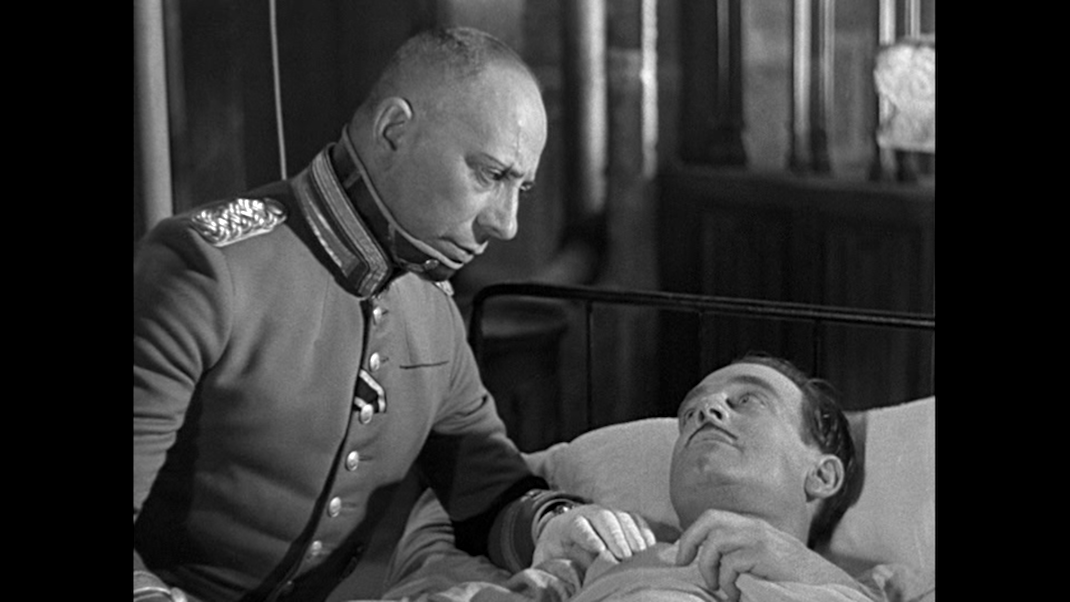
It is the only act of violence in this "war movie," and Boëldieu—mortally wounded—is Grand Illusion's only casualty. "I aimed at your legs," Rauffenstein tells him. "I was clumsy." But Boëldieu assures him he would have done the same—"French or German, duty is duty"—and of course he would have, for the two men are almost the same. (Almost, but not quite. "So that's why," Rauffenstein mutters, as he is informed that Rosenthal and Maréchal have escaped. He had considered the possibility that Boëldieu had gone mad, but he had never considered the possibility that Boëldieu would sacrifice his life for two commoners like Rosenthal and Maréchal.)
There is incredible, almost startling tenderness in this scene, as Rauffenstein comforts the dying Boëldieu. Boëldieu himself stays himself until the very end, maintaining the good-natured, unsentimental, stiff-upper-lip he has worn his whole life. But Rauffenstein is almost inconsolable, and Boëldieu is wise enough to know that Rauffenstein—whether he knows it or not—is really mourning for himself. "I'm not the one to be pitied," Boëldieu says. "For me it will all be over." Grand Illusion is a movie about prison breaks, after all, and Boëldieu, in his own way, is making his escape out of what he and Rauffenstein both recognize as a "futile existence."
So Boëldieu is the one who dies, but what gives this scene such sadness is the tragedy of Rauffenstein. It is Rauffenstein—who says he missed his chance to die in battle—who will remain trapped in this prison. It is Rauffenstein who will stay isolated in his tower, a sad, claustrophobic facsimile of a decaying aristocracy. It is Rauffenstein who will remain forever isolated, because he is unable to change, unwilling to ever lower those walls between himself and the rest of humanity. Boëldieu's hands, at last, are bare, but even in this most intimate moment Rauffenstein still touches his only real friend through those white gloves. He watches Boëldieu die, and, as the snow falls outside his window, our last shot of Rauffenstein is of just those white-gloved hands, cutting the bloom off his precious geranium. The film leaves him there, alone now, in a place where nothing grows at all.
ACT FOUR: FREEDOM
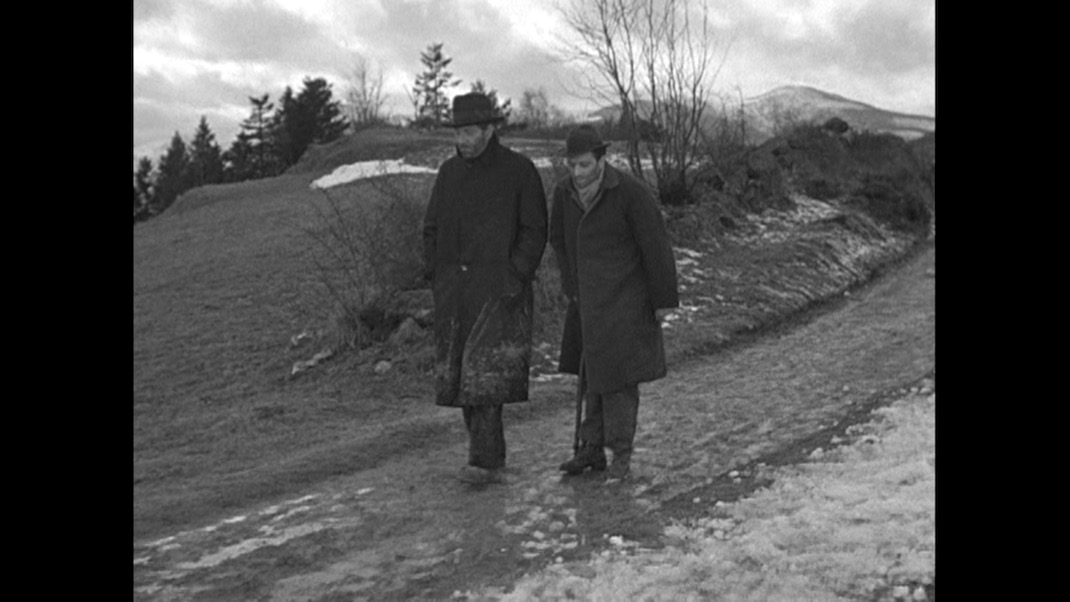
On my very first viewing of Grand Illusion, it was strangely worrying to realize there were still 24 minutes of film left after we leave Wintersborn. The climax there—of Rosenthal and Maréchal's escape, and of Boëldieu's death—had felt like such an exquisite completion of our journey with these characters that anything more seemed potentially like a mistake. Oh, no, it should have ended right here, I thought. I don't need to know what happens next. I felt strangely protective of the perfection of Grand Illusion to that point, and I worried Renoir was offering us, at the end of his own movie, the sort of diminishing-returns sequel that no one really wants.
And, to be honest, some aspects of that feeling never completely went away. I've watched Grand Illusion perhaps half-a-dozen times now, and somehow this final act in the Bavarian countryside still comes as a surprise, every single time. It feels like an epilogue, or a coda. It feels, almost, as if we are in a completely different movie.
So it is always disorienting, this final act. And yet it is impossible, now, to imagine Grand Illusion without it.
Certainly, it is a startling change of venue. We have spent the entire movie in crowded, claustrophobic spaces: the officers' clubs, the camp at Hallbach, the prison at Wintersborn. (Even in the travel montage, we only viewed the passing villages from a train-car window.) Now we find Maréchal and Rosenthal walking freely through the great outdoors, over wide-open fields and rolling hills, the views stretching back to majestic, snow-capped mountains that disappear into an infinite sky. They are dressed in civilian clothes, mud-caked and ill-fitting. They are cold, and they are starving, and Rosenthal is limping, and they seem in every way diminished from the men we knew before. Outside of the prison camps, away from their jailer and compatriots, they seem to have no context: It is as though we have followed two actors home after the play has ended.
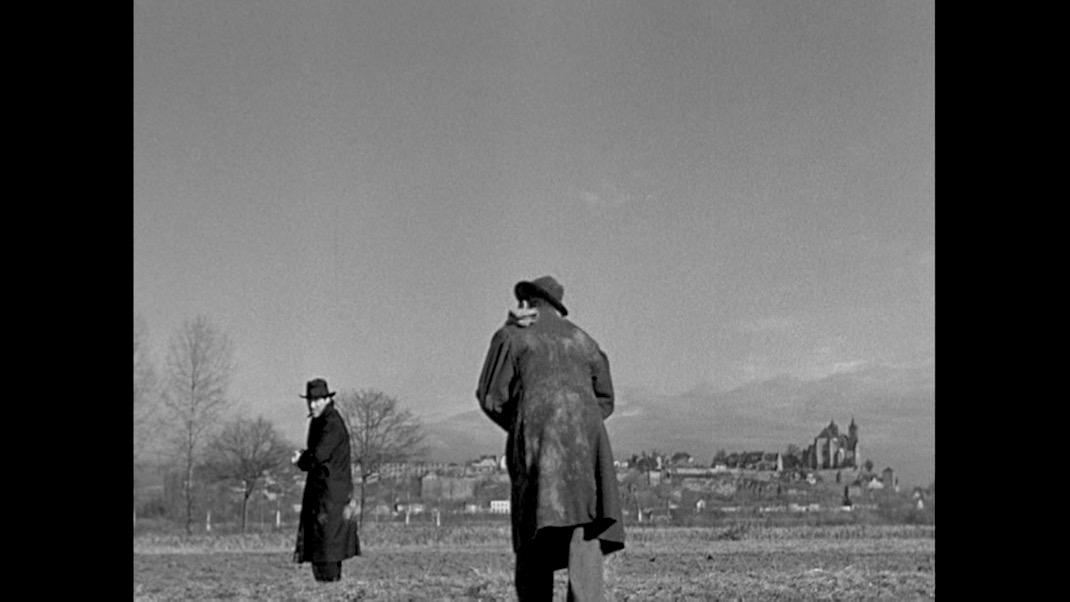
And this, I think, is exactly the point. There are many possible meanings to the film's title—which Renoir reportedly decided upon only after principal photography was finished—but surely one of them is that war itself is an illusion: an unnatural, manufactured thing, played out according to arbitrary rules, which creates artificial friendships, enmities, communities. The changes wars effect may be real and lasting, but Renoir shows us war itself as a temporary, semi-controlled experiment: a sort of game, a sort of theater, a sort of play.
But now Maréchal and Rosenthal are somewhat off the stage (though obviously still trapped, like everyone in Europe, in the larger theater of the war itself). The military provided them identities and boundaries and rules. Hallbach and Wintersborn provided them with identities and boundaries and rules. But now they're in the real world, stripped, to some extent, of all three. Like the move to Wintersborn, this too, then, is a necessary new phase of Renoir's study: to examine how the changes these men have undergone—the lessons they've learned, the lowering of the social barriers they've managed—are retained once they are freed from the enforced social incubator of prison.
And it does not begin well. Outside of the artificial bubble prison provided, affinity across social lines does not come so easily. Filthy, and freezing, and so hungry that Maréchal has eaten the buttons off his coat, they are a wretched, miserable pair. They sleep at night huddled together for warmth like lovers, but by day they squabble, bicker, grumble, resent. "You've been a real pal," Maréchal told Rosenthal, before they left Wintersborn—but that was back when Rosenthal was keeping him well-fed. Now that they are starving—and now that Rosenthal, limping, has become a burden rather than a benefactor—those divisions of class and faith, which had seemed so permeable before, reassert themselves.
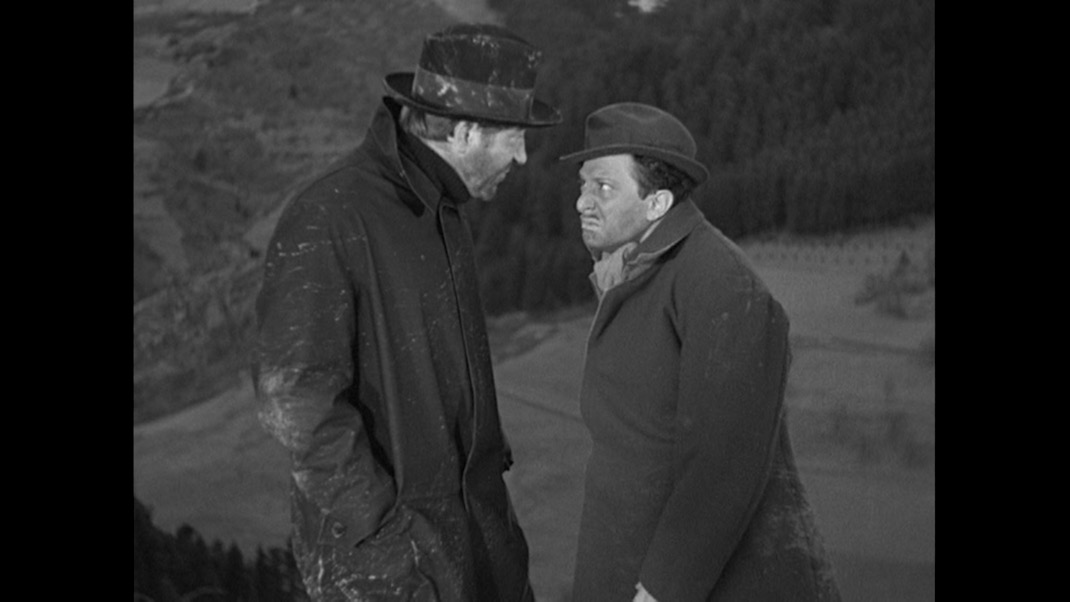
In what is—remarkably—the only truly ugly, angry, hateful scene in Grand Illusion's entire treatment of war, the frustration and resentment between the two men explodes. As they stand on the craggy edge of a precipice, they scream at each other. "You're a dead weight, a ball and chain!" Maréchal yells, and his latent anti-semitism rises to the surface. "I never could stomach Jews!" And Rosenthal, hurt and furious, lashes back: "If you only you knew how you make me sick!" he screams. "Get lost! I'm sick of your ugly mug!" They declare their intention to part company forever: Maréchal storms away, and Rosenthal—proclaiming himself so happy to be rid of Maréchal that he could sing—begins furiously belting out a song.
Like the La Marseillaise scene, it is music used in anger, weaponized into a tool of division. But watch what happens. Renoir cuts between them, each in their own shot: Rosenthal sitting on the cliff's edge, and Marechal storming away across the field.
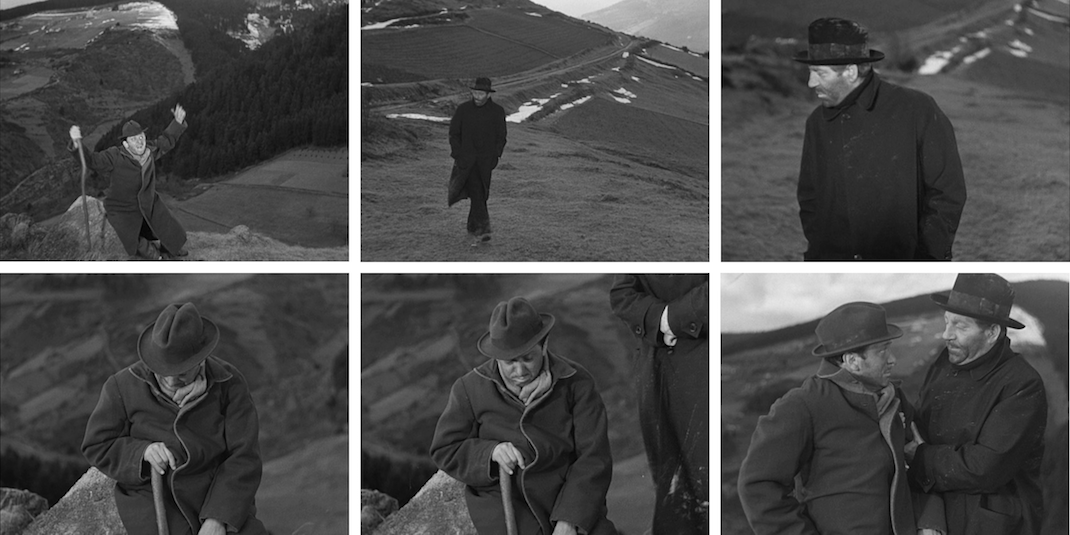
But then Maréchal recognizes the tune Rosenthal is singing, and begins singing it back to him angrily, and the music becomes a bridge connecting them in their separate shots. The song, of course, is Boëldieu's song, "La Petit Navire," a song in which cruel inhumanity is overcome by forgiveness and grace. Just a few phrases into the song Maréchal's voice changes, becoming softer, and he realizes Rosenthal has stopped singing altogether. We cut back to Rosenthal, and find him sitting alone, crying. A moment later, Maréchal appears in the frame within him, and helps his friend to his feet. The small miracle has happened, and the two men walk out of frame, together, moving away from the edge of a literal and spiritual cliff.
It is as though this has been a test on everything they have learned throughout Grand Illusion, and they pass. There will not be another word of anger spoken in the movie. And these two men, brothers now, find, as their reward, a home, and a family.
As we are introduced to Dita Parlo's Elsa, let's look one last time at Renoir's simple but very deliberate blocking and shot-setup. The scene begins in a two-shot, with Rosenthal and Maréchal—now reconciled, and so discovered as a unit—huddling together in Elsa's barn for warmth. They hear someone approaching, and it is a mark of how their relationship has solidified since the last scene that Rosenthal tells Maréchal to run, and leave him behind, but Maréchal refuses. Instead, Maréchal grabs a piece of wood and hides behind the door, prepared to club anyone who comes through. With all the general goodwill Grand Illusion has generated throughout, this moment is a startling reminder that these are soldiers at war, hunted behind enemy lines, and they might have to kill to ensure their freedom.
And so we get a close-up of Maréchal alone, his weapon poised, for in this moment he—a potential killer—is cut off from humanity. It is not an enemy who enters, however: First it is a milk cow—a placid and feminine symbol of the normal and natural world—and then it is Elsa, a beautiful young woman, and—as we'll learn—a mother and widow. The war, with all the distrust and discord it breeds, still hangs between all three characters for a few moments: Elsa has every reason to believe she could be robbed, raped, or killed, and the men have every reason to fear that she might sound the alarm and get them captured or shot. And so Renoir's camera and editing isolates all three characters, as Elsa looks to Maréchal, and then to Rosenthal, and back again.
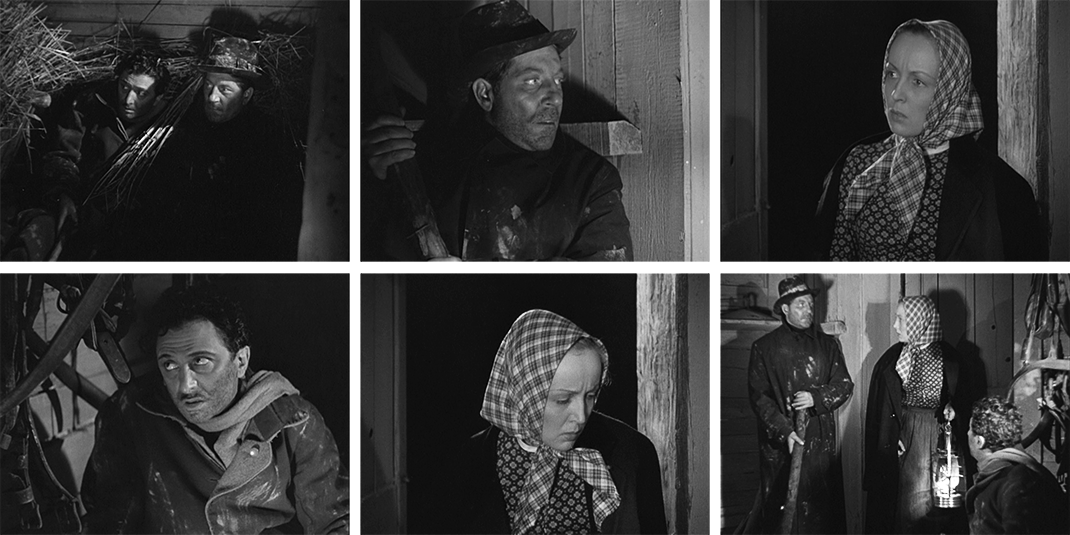
I suspect I'm belaboring the point here, but I think it's a point worth repeating: When Renoir makes a cut, it's for a reason. In this very small space, it would have been simpler and more practical to shoot this entire brief scene from a few feet further back in the barn, taking in all three characters at once. But instead, Renoir is careful to give us isolated, medium close-ups of each character, showing us the fear and distrust on their faces, as divisions of nationality, gender, and language hang between them. Fortunately, here, all these artificial enmities are quickly resolved: Maréchal lowers his weapon and assures her they are not thieves; Rosenthal (who speaks German) explains that he is injured; and Elsa's fear turns into sympathy, concern, and hospitality. She invites them into the house, and only then—the artificial divisions dispensed with—does Renoir unite all three characters in the frame, and allow them to leave the barn together.
Inside Elsa's cozy home, as she feeds Maréchal and tends Rosenthal's foot, this remarkable new trust is almost instantly solidified. The sounds of singing and marching feet alert them all that a German patrol is passing, and there is a knock on the window. Curiously—though Rosenthal jumps up—Maréchal doesn't even put down the sandwich and glass of milk in his hands, as though he already knows Elsa will never betray them. She goes to the window, and simply gives directions to the sweet-faced, bespectacled, very young German soldier who appears there. The danger—and any distrust that existed between these people—has passed.
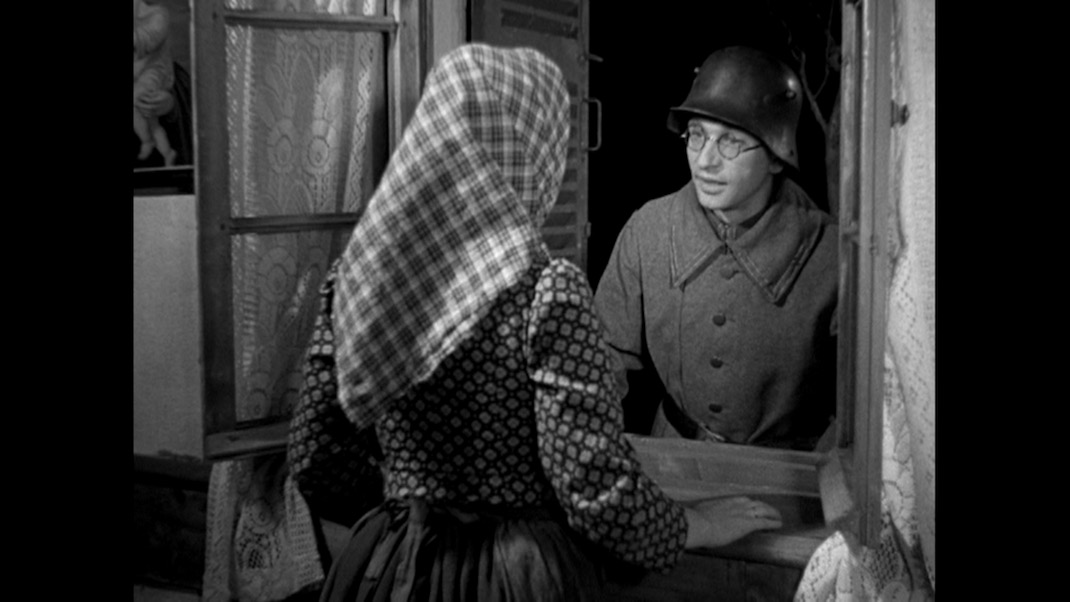
In the subtlest of ways, this epilogue brings back earlier moments and elements of Grand Illusion, putting them into a new and more mature perspective. Earlier in the film, back at Hallbach, the prisoners stood in the window watching young German soldiers drilling in the yard to fife music: They were "children playing soldier," in Boëldieu's words. One of the other prisoners said the sound was "stirring," and Maréchal observed "It's not the music that gets to you: It's the marching feet." Now, the marching feet and music announce the arrival of one of these "children," fresh-faced and friendly, achingly human, marching off to probably die on the losing side of a terrible war.
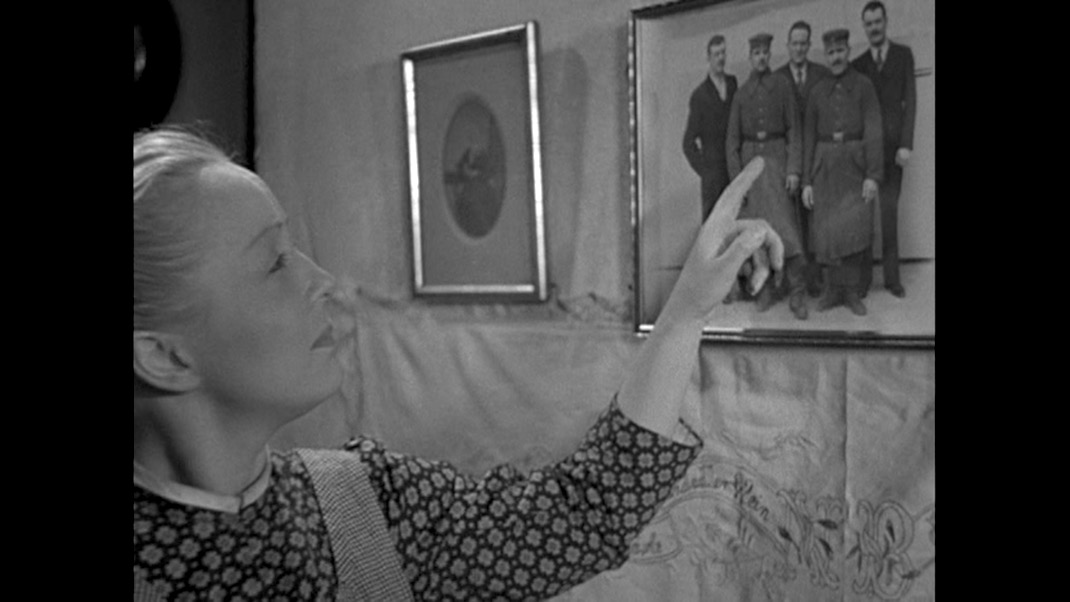
The very next scene deepens the point. Up until now in Grand Illusion, we've seen characters treat war as a game, and we've seen the film treat war as a social experiment. Our only real reminder about the real-world consequences of war came from the old women who watched those "poor boys" training to be soldiers. Now, the only other woman in the movie—Elsa—provides a true accounting of what this "game" has cost. She shows the men the photographs on her wall: her husband, killed at Verdun, and her three brothers, killed at Liège, Charleroi, and Tannenberg. She does not even say their names, just the names of the battles in which they died: "Our greatest victories," she says bitterly. And here again, with the singing of the young German troops fresh in our ears, we remember the battle of songs at Hallbach—the Germans singing to celebrate their taking of Douaumont, and the French singing their anthem to celebrate taking it (temporarily) back—and we feel the utter futility of war as anything to celebrate. Those victories at Douaumont were illusions. The victories at Verdun, Lèige, Charleroi, and Tannenberg were illusions. Only the death is real, only that empty table in Elsa's kitchen that is, she says, "too big now."
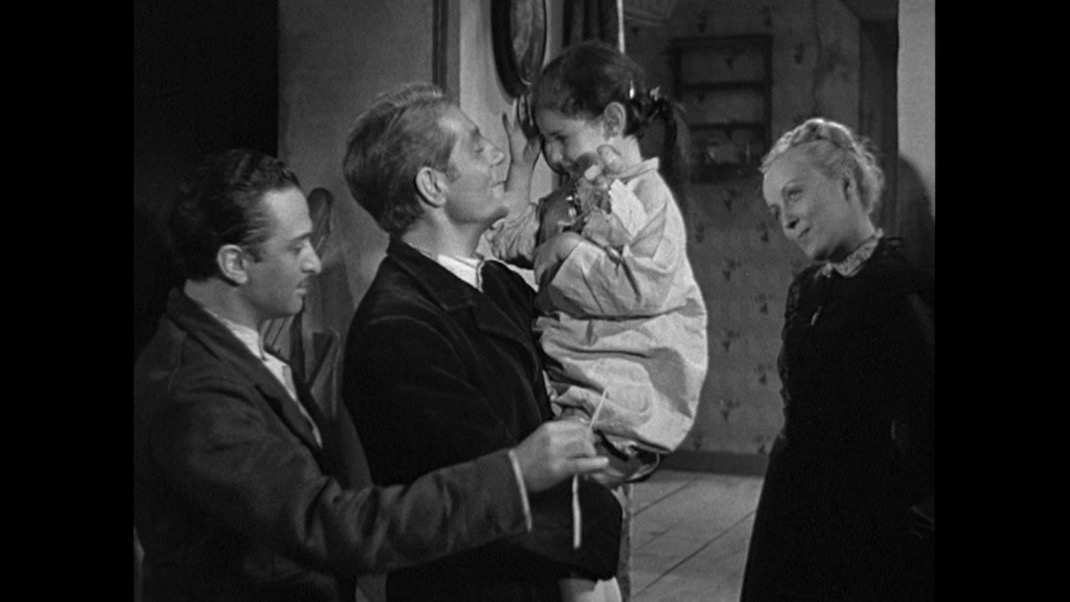
This, to me, is what this final section of Grand Illusion provides: an absolutely essential counterpoint to the destructive and divisive artificiality of war. What Maréchal and Rosenthal find, on that small farm with Elsa and her ridiculously cute daughter Lotte (Little Peters), is nothing more or less revolutionary than a normal, natural, peaceful life. Like the easy camaraderie of the musical revue, this is how life could be, should be, without all the illusory walls—nationality, class, faith, gender, language—that separate people. Maréchal—clean, clean-shaven, plump, healthy, and happy—is a man transformed. He talks out loud to Elsa's cow while doing chores, and the words are almost a gentle parody of the film's genuine message. ("You're a cow from Würtemberg, and I'm a working man from Paris, but we can still be pals," he says. "You're a poor cow, and I'm a poor soldier. We each do our best.") He and Rosenthal become affectionate uncles to Lotte, filling out those empty seats the war left around her kitchen table. Rosenthal is Jewish, but he makes a makeshift Baby Jesus—"One of my ancestors," he jokes—so Lotte can wake up to a creche on Christmas Eve. And Maréchal and Elsa fall in love while barely speaking a word of each other's language. His fumbling efforts to express his affection in German—"Lotte hat blaue augen"—and Elsa's later attempts to learn French, are gestures across the barriers of language and nationality, but they're almost moot, because those barriers have all but disappeared anyway. (Rosenthal's services as translator become increasingly unnecessary. "For 18 months I never understood the guards," Maréchal says. "But her I understand.")
Boëldieu has not been forgotten. On Christmas Maréchal and Rosenthal invoke his name, and wonder whether he lived, but they agree not to talk about him. His sacrifice was real and noble, but all of them were right: The Boëldieus and Rauffensteins have no place here. As Maréchal had predicted, it is difficult to imagine Boëldieu cuddling with his compatriots in the mud for warmth when they were "on the skids," and it is nearly impossible to imagine him now, in this idyllic family formed without regard for nationality, class, gender, or faith.
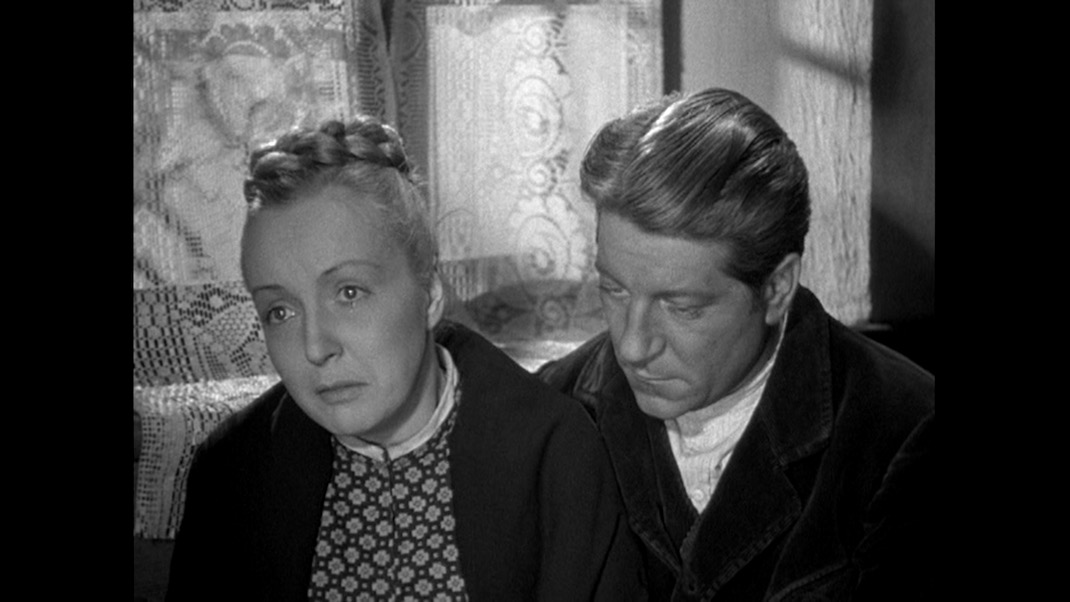
And this is why the ending of Grand Illusion will always be so ambiguously bittersweet to me. For Maréchal and Rosenthal decide they must return to the war, and give up—for now, at least—this utopian idyll, this little oasis of peace and love. Maréchal tells Elsa that he will come back, after the war, and that she and Lotte can come with him to France then. In this last real conversation they share, he speaks in simple French, and she in simple German, but how much either understands of the other's words is unclear. Renoir shoots them both facing the camera, not looking at each other, and—though we are hopeful they might recreate this miraculous family after the war—it feels as if some of those phony divisions have opened up between them again.
The men depart, and Maréchal does not look back. "If I do, I might never leave," he tells Rosenthal. Our last view of the house fades on little Lotte, sitting alone at a table that is once again far too big.
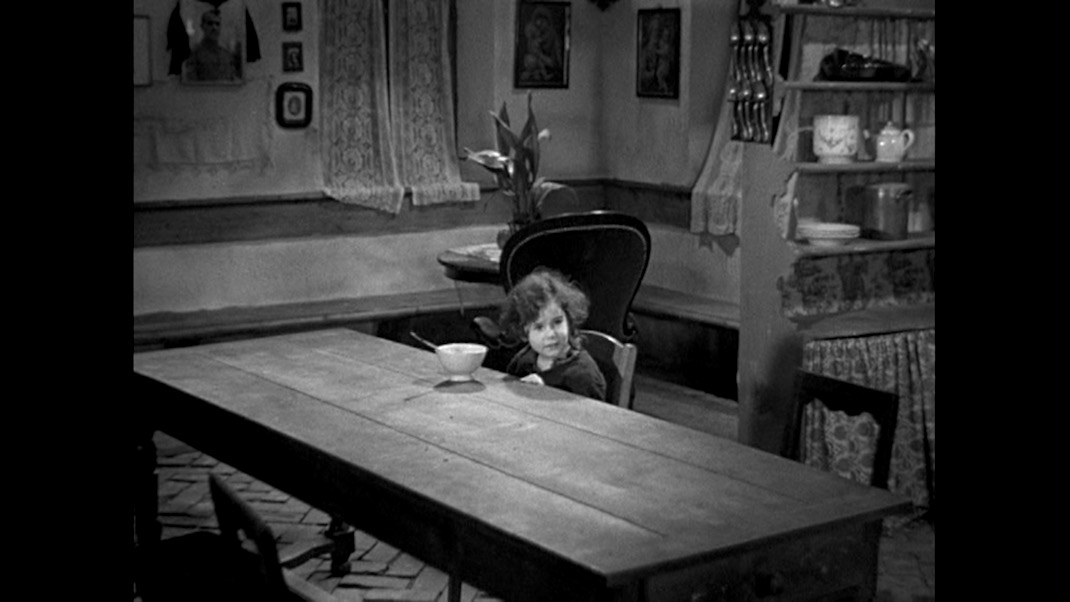
The ending of Grand Illusion was always going to be bittersweet. In the film's original treatment, Maréchal and his fellow escapee (the character of Rosenthal did not yet exist) would have agreed to meet up in Paris, at Maxim's, on the first Christmas Eve after the war has ended. The final shot of the film would have been of Maxim's on December 24, 1918, and of a reserved table at which, sadly, no one was sitting.22 Whether Renoir's intention was that one or both men had been killed, or that one or both had just not bothered to show up—their friendship now revealed to be yet another illusion of wartime—I don't know, nor do I know which interpretation would have been more bleak.
But, ultimately, Renoir changed his mind, and decided to end the film on a more hopeful—but still ambiguous—note. Maréchal and Rosenthal trudge through the snow towards the border between Germany and Switzerland. Picking up on a specific motif that has been present throughout—Boëldieu's mysterious smudge on the map, Maréchal's ignorance of a "cadastre," etc.—this all important boundary is the final great illusion, of course, an imaginary and arbitrary invention. ("You can't see borders, they're man-made," Rosenthal says, underlining the point. "Nature couldn't care less.") A German patrol spots the two men and begins to fire on them—but then one of them orders the others to stop shooting. "They're in Switzerland," he says. "Good for them," another replies—a final expression of empathy and goodwill between soldiers on opposite sides of arbitrary lines. The film fades to black as Maréchal and Rosenthal—now just two tiny, anonymous dots disappearing into the snow-covered hills—escape to an uncertain future.
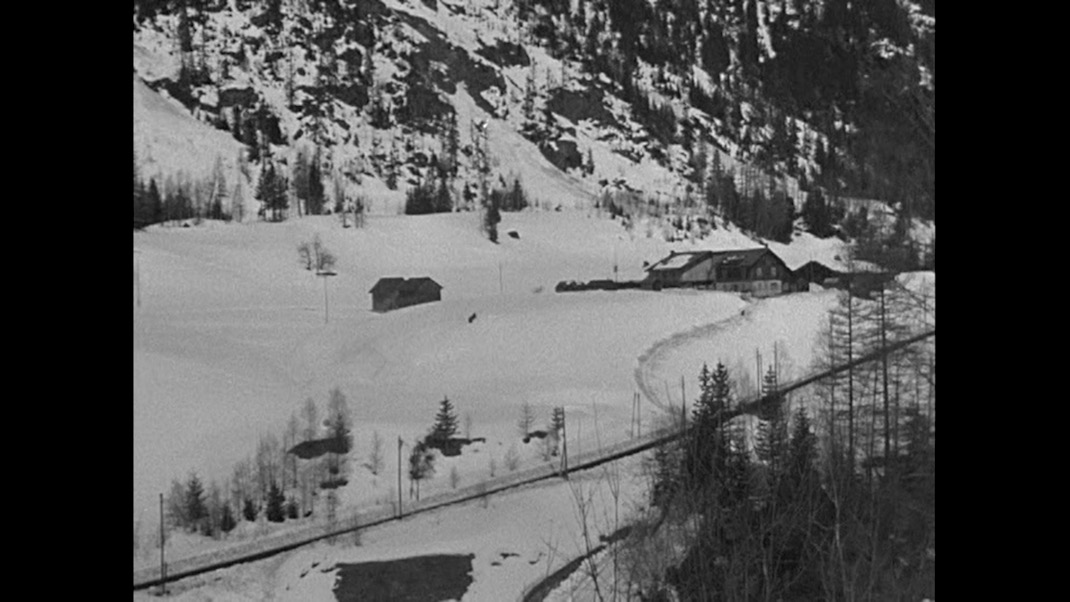
It is a perfect ending, an appropriate ending, even an optimistic ending—but it is not, quite, a happy ending. The two friends escape Germany, but they do not escape the war, and we don't know what happens to them after we lose sight of them in the snows of Switzerland. Do they become separated, or stay together? Do they survive the war, or perish in it? Does Maréchal ever come back for Elsa and Lotte? Or do they become more and more like a dream to him, as the great lie of war reasserts its influence over his life and character? Will he retain the lessons of the film? Will he be able to remember what is real, and what is illusion?
I confess, it bothers me that he leaves her. "She'll just have to wait," Maréchal says of his Josephine, at the beginning of Grand Illusion, before he goes up in a plane with Boëldieu, to be shot down by Rauffenstein. One suspects Maréchal never gave Josephine another thought, and now he is saying that Elsa, too, will just have to wait, while he goes off to play at war. Has Elsa and Lotte's too-large table replaced that empty table at Maxim's as the image that lingers after Grand Illusion's final screen goes black?
It was never going to be a fully happy ending. "I overestimated the power of cinema," Renoir wrote in 1974. "La Grande Illusion, for all its success, did not prevent the Second World War."23 It must have been a bitter disappointment: his film had celebrated the common humanity of the French and German people, but after the war he acknowledged that the Nazis had "almost succeeded in making the world forget Germans are human."24
But one suspects, from the film's bittersweet ending, that Renoir must have known, even in 1937, that one movie would not, could not, eliminate inhumanity, or prevent the madness that was about to be unleashed on the world. He must have known then that men will always go back to war, and that the sort of utopian peace Maréchal found with Elsa could never last. He must have known that the draw of the grand illusion is strong, and seductive. He must have known that, while the lines that divide people are always shifting, they will never fully disappear. Grand Illusion is not, in the end, a film to fix the world, but one that celebrates—and perpetuates—those tiny moments of kindness and understanding that make the world endurable. That is the real power of this funny, sad, quietly profound masterpiece: A century after the war it depicts had ended, decades after the war it failed to prevent was over, Grand Illusion still argues for hope, still generates empathy, and still makes everyone who watches it a little more human.
That is the mysterious power of all great cinema, all great art. It never does change the world, really, except in the smallest, least tangible, and most important ways.
NEXT ON THE SYLLABUS
The plan for the coming year is to get my long-neglected Independent Study in World Cinema back on track, with new (almost certainly shorter) posts appearing around the 15th and 30th of each month. Next up, happily, is further study of Jean Renoir, as I set out to learn The Rules of the Game (1939). Then we'll bounce back and forth across Western Europe for a few weeks—for Rossellini's Rome, Open City (1945), Cocteau's Beauty and the Beast (1946), and De Sica's Bicycle Thieves—before heading much, much further east. Subscribe below, and/or follow me on Twitter, to be notified when new articles are posted.
Notes
- Roger Ebert, Life Itself (2014), dir. by Steve James.
- Jean Renoir, My Life and My Films (New York: Atheneum, 1974), 19–20.
- Ibid, 33.
- Ibid, 40.
- Ibid, 41.
- Ibid, 42-43.
- Ibid, 51.
- Ibid, 85.
- Ibid, 140.
- Quoted in Penelope Gillatt, Unholy Fools: Wits, Comics, Disturbers of the Peace (New York: Viking, 1973), 317.
- Stuart Klawans, “Renoir All Over Again,” The Nation, Nov. 14, 2002.
- Janet Maslin, “A Renoir Masterpiece, Refurbished and Timely,” New York Times, Aug. 6, 1999.
- Pauline Kael, I Lost It At the Movies (London: Marion Boyers, 1994), 110-111.
- Orson Welles on The Dick Cavett Show, July 27, 1970.
- Kael, 111.
- Francois Truffaut, interviewed in April 1984 by Bert Cardullo, published as “Truffaut’s Last Interview,” Richard Brody, The New Yorker, July 29, 2010.)
- Quoted in “Jean Renoir’s La Grande Illusion,” Alexander Sesonske, The Georgia Review, Vol. 29, No. 1 (Spring 1975), 210.
- Renoir, 280.
- “Only where love and need are one/And the work is play for mortal stakes/Is the deed ever really done/For heaven and the future’s sakes,” from Robert Frost’s “Two Tramps in Mud Time,” 1934.
- See Arthur Lennig, Stroheim (Lexington: University of Kentucky Press, 2000), 445.
- Sesonske, 232.
- Film historian Peter Cowie describes this original ending in his audio commentary for the Criterion DVD of Grand Illusion.
- Renoir, My Life and My Films, 125.
- Jean Renoir, La Grande Illusion, Trans. Marianne Alexander and Andrew Sinclair (London: 1968), 8.

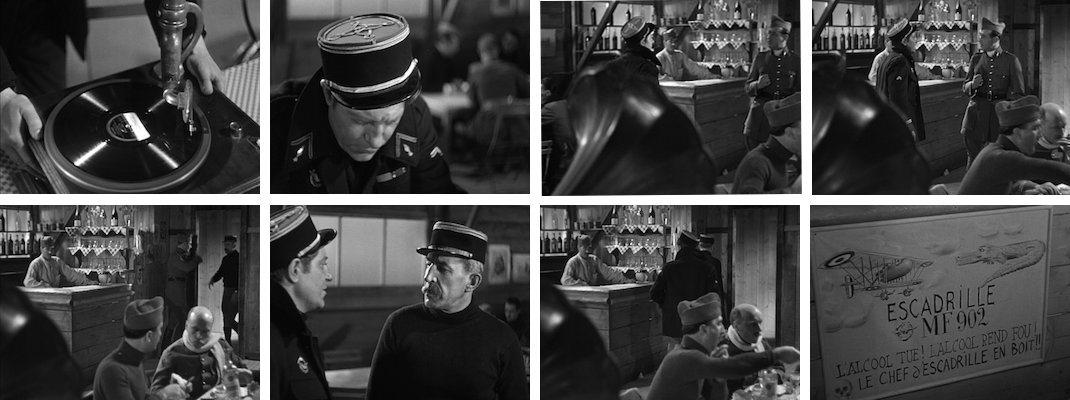


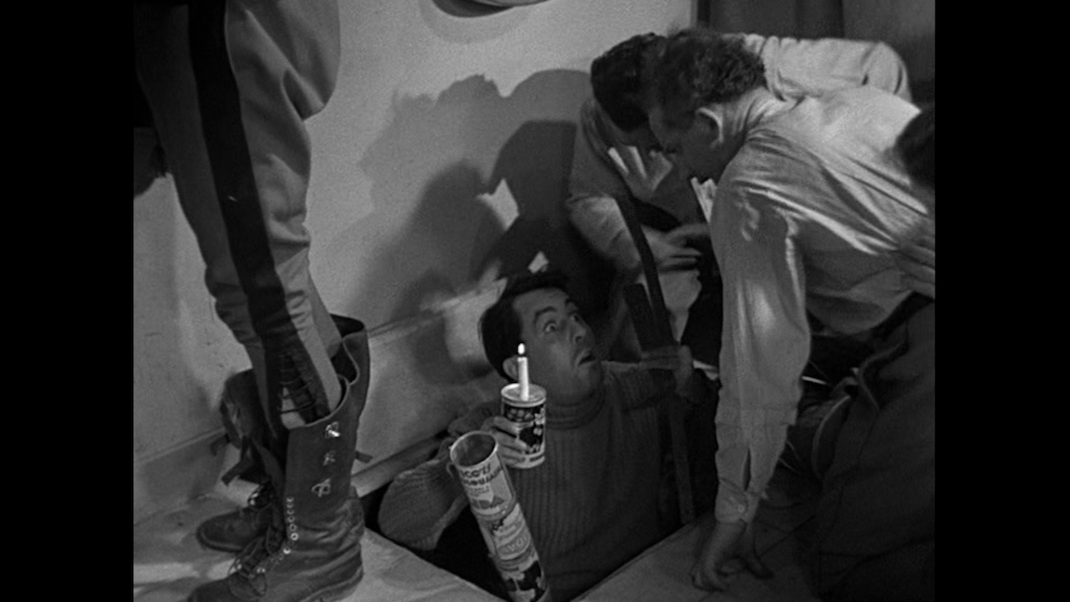

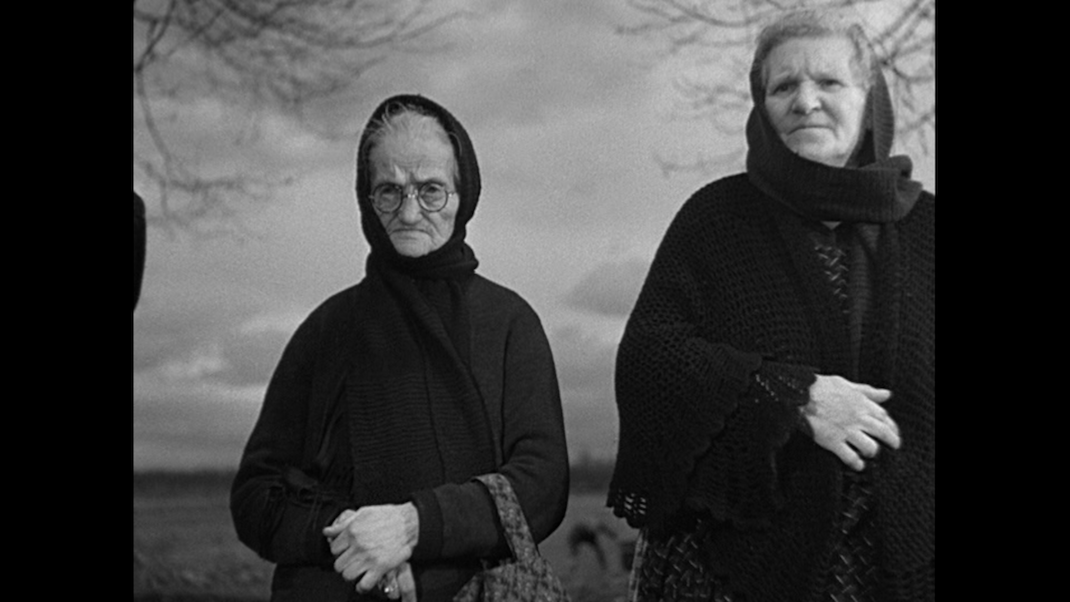
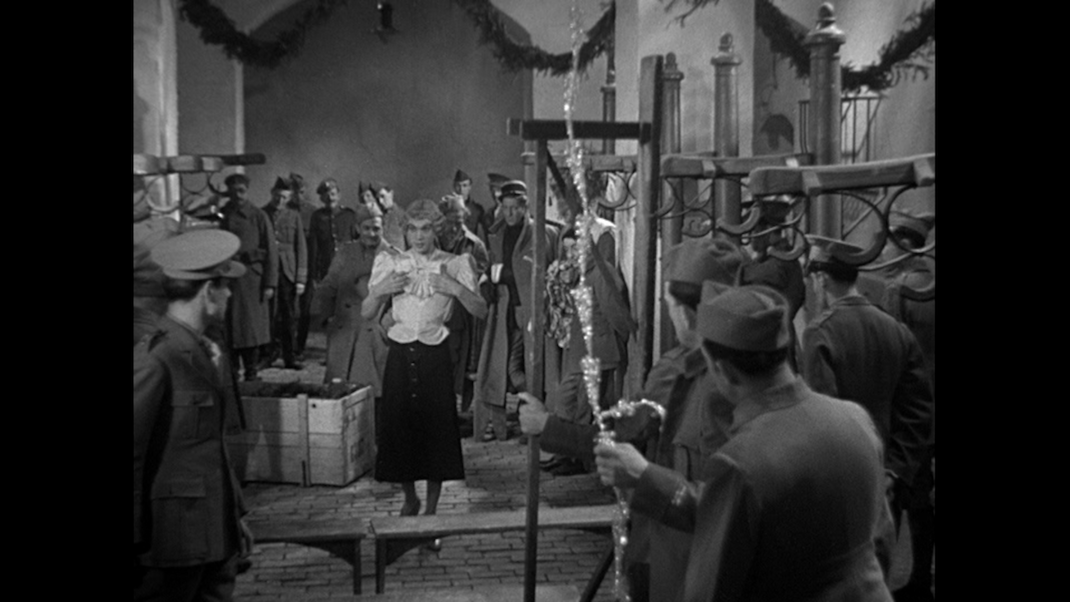
4 thoughts on “GRAND ILLUSION (1937)”
I'm on your email list and am glad I clicked on the link. I can't say I'm a big fan of B/W or foreign films, but this was a good read, thank you.
Hey, Rob! You were a Game of Thrones man, if memory serves, but I'm glad you're still here, and I'm glad you enjoyed the post. If you get a chance to see the movie, I highly recommend it (obviously): It really is a great one.
This essay solves many mysteries that this film has held for me. Its gentleness wasn't easy to understand because of its themes of war, men, prison, escape, etc. Now I see more clearly Renoirs delicate messages of sacrifice, forgiveness, sameness. The escape plan and its failure were unimportant to Renoir, just part of the game of war, the Grand Illusion. Rauffenstein also represented the Grand Illusion of the dying aristocracy. I can't wait for your analysis of The Rules of the Game. Its my favorite Renoir film. Thank you for taking the time to reveal the power, beauty and delicacy of this film to me.
Welcome back, Carol! I checked to make sure you were on our mailing list when I posted this, because I remembered you liked these posts. I'm glad you're still here, many years after the last one was supposed to appear.
Though I've said it before, I really am going to try to keep these coming regularly, though that will probably necessitate making them shorter. (I suspect they'll become more "essays on the movie" rather than "scene-by-scene walkthroughs of the movie." But we'll see: I do tend to get obsessive about the details.)
I'm looking forward to The Rules of the Game, though not without a little trepidation: I understand they're very different films, but I loved this one so much it's hard to imagine Renoir topping it.